Articles
Please click the article titles below in the tabs to read each full article.
- Interview with Dr Virginia Button - 2021
- Vivid Moments in Art- Interview 2021
- Tremenheere, mentorship, friends and family
- Force Majeure by Matthew Bennington
- Force Majeure by Geoff Hands
- Talking art, life, being buried overnight and outsider artist Palmer White
- By Writer John Harvey
- By Artist and Writer Paul Becker
- Tate 'Art Now’ by Susan Daniel - McElroy
- Review by Linda Cleary
- In praise of collaboration
- By Artist Michael Angove
- Rupert White on Depicting Children and "Vigil" Show
- Look back In wonder 2019
September 2021 – Interview with Dr Virginia Button – On my recent work and its influences.
Art historian, writer, curator and teacher with expertise in modern and contemporary British Art. Director of Falmouth School of Art (2013-18) and formerly a curator at the Tate Gallery and Tate Britain (1991-2001), curating the Turner Prize from 1993 to 1998.
She has written extensively and authored books on The Turner Prize (1997, 5th revised edition 2007), St Ives Artists: A Companion for Tate St Ives (2009), and for Tate on Christopher Wood (2003), Ben Nicholson (2007) and Lucian Freud (2015).
- VB – I’d like to begin by asking about the significance of Force Majeure, the exhibition held at Tremenheere Sculpture Garden in 2019. It was your first solo show in 10 years and which you’ve described as a ‘confessional portrait’. Why was it important for you then and how do you feel about it now?
Force Majeure was my first solo show in a while as in the previous ten years I’d been focusing my energy on curating large exhibitions and projects including numerous other artists. These were dynamic and collaborative events and through them I was able to explore themes I was interested in. A few years ago I felt the need to produce a solo show to reflect on these experiences, but I was also emerging from a difficult time in my personal life. Force Majeure referenced things that had prevented me being the person I wanted to be. Looking back, I think it represented both a manifestation of the psychological changes I’d been going through in that decade, particularly in my close relationships, and a laying to rest of a troubled time. I guess you could say it was a self-portrait of ten years of upheaval and difficulties that I felt were beginning to be resolved, and the show functioned as a kind of catharsis for me and my painting.
The paintings I exhibited were made very quickly and spontaneously. The show also concluded with an event I curated for the summer solstice involving a large number of artists who made work in aid of the charity Freedom from Torture, enabling me to include my interest in collaboration and curating in a spirit of generosity amongst all involved. So in essence, the exhibition allowed me to pull together different strands of a very diverse practice, but importantly it signalled and re-established my commitment to the pursuit of painting.
The exhibition was like an eruption, an overwhelming deluge of themes and imagery, ranging from dream imagery and myth, personal imagery, people close to me, people I admire, animals, creatures and topographies. These subjects all came together in a frieze of paintings. Since then I’ve been consolidating different strands that interest me, to slow down and carefully consider combinations of imagery, allowing time for things to breathe and co-exist.
The show also helped me recognise the importance of my drawings on tracing paper; their delicacy and fluidity has fed back into my painting, lightening my sense of touch. I’d been fixated on imagery as way of communicating my sensibility, my feeling and ideas, but I’ve since realised that my drawing – the weight of line and its ephemeral quality – can do that just as effectively and perhaps even more so. I learnt a lot about how my drawing relates to my painting. The way I respond to the materials I use and particularly the weight of the paint – its luminosity and colour – is, I would say, key to how I want to communicate.
- I’d like to ask you what motivates you as an artist? Why is painting so important for you?
I’ve always painted, and I’ve also always been fascinated by other artists and the broader contexts that underpin the reasons for making art. I was influenced early on by the Catholic side of my family, which stimulated my interest in religious panting and iconography, and I’ve loved travelling to places like Nepal and Greece, which have rich cultural traditions. I’m fascinated by what motivates people to make art, and have often collaborated with other artists who work in different ways. This eclectic range of interests and influences has fed back into my art practice. But sometimes I’ve felt that my painting can’t hold the weight of all my different interests. It’s overwhelming. In way what I’ve learnt through Force Majeure is that I don’t have to consciously bring all of my interests and experiences together in my painting. They emerge subliminally through the painting process. When I’m painting – perhaps even more so when I’m drawing – I’m completely present – and that’s what I love about painting, not thinking, but being completely present in the experience of creating something.
- You recently described painting as a medium of doubt and speculation. Could you tell me more about how this plays out in your practice?
The philosophical thinking I’m drawn to embraces doubt, particularly for example, existentialism, which tries to respond to the world and experience as it is by stripping away preconceived ideas or comparisons to others. The philosophical position of not knowing, of avoiding ideologies, is powerful for me. It’s where I think we should be in the world at the moment when everyone seems to be an expert and have all the answers. The act of painting lends itself to speculation and invents as it unfolds. It reflects my position of not knowing. I know what I want to say but I don’t want to execute it, I want to find a way of transforming this into something unexpected. All the art I’m interested in is transgressive in some way. What I mean by that is it has some kind of flaw; it has a vulnerability and subtly. I often see that in historical painting.
- What do you see as the key recurring themes in your work? In particular could you talk about the importance of your family as a key subject?
Since working on Force Majeure I’ve become aware that family dynamic is the dominant theme in my work, not just my own family, but the idea of family as a set of ever-present, ever-evolving, complex and shifting relations that are always challenging you, pulling the rug from under your feet. I’m especially attracted to Greek myths and Greek art as they lay bare the dynamics of family relationships and hierarchies, their jealousies and rivalry, desire and trauma, love and betrayal.
As a figurative painter, I’ve often looked to those closest to me for subjects. But when I think about family I also think about the cultural icons, the writers, film-makers and musicians who have shaped me. I kind of idolise them and their work. What they have achieved as creative people is phenomenal. The feeling of adoration of another for me is to do with love, and it’s something that I’m aware I keep coming back to in my work. This extends to animals and nature. They have always been present, but it’s difficult not to feel concerned about our disregard for other creatures and nature and increasingly I want to bring that more into my painting.
- Have any of the Greek myths been of particular interest to you?
I find the story of Achilles particularly powerful, that when he was an infant his sea nymph mother Thetis tried to protect him from his tragic fate by dipping him into the river Styx to make him immortal. But she held him by his heel, which according to the legend later proved to be his fatal flaw. The Greek myths deal with the unbridled horror and difficulty of life and of being human. The stories are so visual and visceral, and have an intensity of feeling that I respond to. I’m fascinated how the emotion of love drives humans to extremes, as for example, in Toni Morrison’s novel Beloved which is one of my favourite books. Travelling around Greece and Turkey when I was younger I also read Ovid’s Metamorphosis, which has had a big impact on me, it’s beautiful, images of human beings, nature and transformation – it just blows your mind!
- Why are you attracted to ritual and religious imagery? Can you talk about your fascination with ancient cultures and why they excite you?
I love visiting London to see contemporary art shows, but I always end up at the British Museum because I love being in the presence of ancient art work. I feel a connection with the art work rather than the individual artist, and a sense that I’m looking at a society, a culture that existed at a particular time, rather than a singular vision. There’s something about that that really gets to me. I think it’s an impossible task now to achieve that same sense of collective authorship in an art work, but I like the activity of trying to take myself out of the equation. Obviously I’m never going to achieve that! I guess I’m also fascinated by art from earliest times, from cave painting to the Aztecs, because it speaks of the diverse motivations underpinning humankind’s need to make art. It’s provocative and challenging. I used to work as a technician at the Royal Academy in London and one of the most powerful experiences I had was installing an exhibition of Aztec sculpture. Handling the sculptures I felt a strong identification with them as objects. This was deeply perplexing as some of them were made for human sacrifice.
As a student I became very interested in the idea of ritual and performance and recognised the unique power of enacting something as a way of confronting issues. About ten years ago, I collaborated with another artist to make a series of ritualistic objects. We realised we couldn’t do this without an appropriate belief system so we invented an outsider artist. Through the lens of this imaginary figure we were able to produce some interesting artworks using ritualistic protocols. I guess what I’m trying to say is that I love the collective tensions that are somehow refined to such simplicity in a lot of ancient and ritualised art works.
- What in general is your working process and how might this have changed since Force Majeure? How in particular do your scrapbooks inform your work?
When I was travelling all around Turkey as a student I collected found ephemera and collaged them into a scrapbook, a bit like Kurt Schwitters. Later when I was studying at the Royal Academy I realised that the book encapsulated my experience of Turkey, the texture, the palette, its religious iconography, its incredible landscapes. The wonder of it all was embodied in the book. I recognise now that scrapbooks are about getting all the things I’m interested in one place. The process of assembling and sticking collected fragments on their pages is relaxing but also obsessive and frenetic for this reason.
The scrapbooks have been made over a period of ten years and they contain all the imagery that I find interesting, that mean something to me, images of my family, my kids especially, the cultural icons and the films I love, the places I’ve visited, and somehow they all get mixed up in the books. Recently I’ve been trying to translate pages from these books into my painting, but I’ve realised that I can’t just lift a page out of a scrapbook and turn it into a painting. In a way the books are of interest precisely because they’ve been assembled over a long period, and they’ll never be finished. I’m beginning to take this approach to my paintings.
Alongside the scrapbooks I made a huge number of line drawings. When the children were growing up, I was constantly drawing them moving through the house with the plants and dogs. These lyrical line drawings were the only thing I could do at that time, but lately I’ve come back to these, recognising them as key my feeling for line. So I would say that my line drawing and the collage scrapbooks underpin my work. All aspects of my practice, including curated projects, end up in a scrapbook.
- Do you use the scrapbooks as places to work things out?
No, I try not to use them in that way, I try not to contrive images, they just end up together. I use tracing paper to overlay some of the pages, so there’s an accretion and layering. But it’s important for me to work spontaneously when I’m pasting – it’s not important whether they work or not as images, it’s quite unconscious. For me, the process of collaging – and a lot of art-making – is born out a kind of manic need to get things down, to get things on the page. Things surface from this process, for example, some books have become about certain interests or issues, such as exploring ideas of the family, masculinity, my son, my relationship with my partner, but they have evolved in this thematic way over time.
- You have recently been working on a series of portraits titled Descendants. Can you describe these portraits and what they mean to you? Are you trying to capture a likeness or the essence of a person? Why make portraits? Most figurative artists make self-portraits but you’ve never done this which seems curious.
In the last year I’ve focused on painting a series of portraits. These have enabled me to really home in on lightening my sense of touch as a painter through the simplicity of trying to depict just the head. I’m now working on more complex assemblages of imagery and collage, but I felt I really needed to understand my approach to representing another human being through colour and touch.
Descendants is based on a series of drawings on tracing paper made in Berlin last year, drawings of my family, friends, strangers in the street, on the tram or train, and drawings made from artworks I saw for the first time Berlin’s museums. These drawings were then exhibited in the public realm in the city. Shortly after this I experienced the death of a very close childhood friend, someone I’d grown up with, who was supposed to come to Berlin. I made a series of drawings relating to when I knew him as a child. Before I knew it every image I was making related in some way to him, whether it was a certain musician we both loved, or my father who he knew really well, and the whole spirit of Berlin and spirit of connection came to the fore. What has also really influenced me is looking at and thinking about Coptic funerary portraits. For me all of the paintings I’ve been making in the series have been about memorialising someone.
The image I might use as a source for a portrait of a cultural icon, for example, the photograph of Lou Reed in my scrapbook – the image itself and where it’s come from – becomes almost like a talisman of something for me. I use found images, photos or video stills and make drawings on tracing paper from these and then try them out over different coloured grounds. This process helps me decide whether or not it the image will have an enduring interest, whether it’s an image I want to pursue. In Descendants some of the subjects are people I don’t know at all and I wanted to paint them in the same way as I paint those with whom I have an intimate relationship.
The series is called Descendants, because I think it’s a beautiful word. I was in Berlin with my daughter and it made me think about my grandmother’s German-Jewish family whose history has been lost. This prompted me to give a drawing of my daughter the title ‘Descendant’. I’m very conscious of where we come from and the baggage we carry, the things that we either address or bury. Who are our ancestors, who are our family? For me this includes not just our blood relatives and inheritance but our cultural relatives, icons or idols, with whom we feel a connection. I really like to blur the idea of who we are. This seems particularly important now, the idea that we are all connected in different ways.
Descendants might be described as a collective portrait. The subjects are very much themselves, but they are also just a vehicle, or projection of the painter – which happens to be me – representing what the painter would like to emulate. So in painting you are trying to say something about someone else, but in the end you’re really working through who you are and what you want or don’t want to be as a human being. That’s why I don’t want to make anything as overt as a self-portrait as I’m doing that anyway. I’m always trying to avoid it, trying to remove myself, however impossible that might be.
- Animals and natural forms have always been present in your paintings of human subjects as foils, companions or attributes, perhaps expressive of subconscious fears and desires. Has your depiction of animals and natural forms shifted in recent years?
When I was travelling in Greece several years ago in the mountains, I made a big scrapbook, collaging images of natural forms, trees, fig leaves, birds, animals and insects. I realised that unconsciously I was taking on themes of metamorphosis from Ovid, with human beings coming out of trees, snakes turning into rivers, but in a stripped back, edited fashion. I now really want the creatures and plants from this scrapbook to become the main stage or starting point for my subject matter. This is partly because of what they offer me in terms of visual qualities, but also there is nothing more beautiful than these creatures we are desecrating, so now more than ever I want to find ways of assimilating them into the work.
- You are a prolific and energetic curator as well as a painter. What interests you about curating and instigating projects with other artists? Do you see this as part of your art practice?
Since curating ‘Revolver’ in 2007 I’ve made numerous, big multi-artist projects, usually in abandoned sites that have presented themselves to me. The themes associated with these sites became the catalyst for the theme of the exhibition or event. It has always been important to me to bring together established and international artists with graduates and emerging artists. This instantly creates an interesting dynamic, often energising the more established artists, and also connected to my interest in teaching and in art schools. I would invite all the artists to respond to the theme or themes of the space. I’m interested in how projects or exhibitions can contribute to the transition of a building or space from one use to another and how collectively artists can effect change. The generosity of artists can be phenomenal. While curating these projects has been incredibly uplifting for me has also be very demanding, so in recent years I’ve tried not to simply repeat the process. I’m trying to take that sense of collective energy into my painting and also to be a bit more discerning about the projects I take on. I am working on a project at the moment in Bristol, called ‘Unstable Monuments’, working with international artists and emerging young creatives in the city. The project is allowing me to further explore the theme of memorialisation, but in collaboration with others. What might it mean to make a monument, to memorialise somebody or something we value in our society? How can we be defiant and political, and how can we channel this in a positive way?
- Which other artists or other influences are at the moment of most interest to you?
What I love about contemporary art is its diversity and I’m often drawn to artists who are doing something completely different to me. I really love a lot of abstract painting and video work, for example, an artist like Gillian Wearing, who is saying things about society and identity that are of interest to me.
- Have the impact of the coronavirus pandemic and the acceleration of global crises in the last 2 years affected your thinking and way of working at all?
I definitely feel that as with other artists this period has given me an opportunity to slow right down. It has been really healthy for me. I even have a large allotment now and have spent a lot of time there! It has been an important time for us to stop and reflect. But I think we’re still in a reflective phase. We don’t yet know how we are going to manifest changes. It has been an extraordinary time. Huge cultural and social issues came to the surface such as Black Lives Matter, and I feel that we’re not quite able to process all of these things yet. But I find this really exciting. It takes me back to the idea of ‘Unstable Monuments’ and the idea of doubt.
On a personal level it’s been about slowing down, simplifying my approach to things and not imposing my view, pulling back and keeping the process of reflection going. My sense of priorities has become more apparent. A lot of artists, including myself, have been able to go back to why they make art in the first place, and that’s been invaluable.
Vivid Moments in Art – Interview with Mercedes Smith
We spotlight Jesse Leroy Smith’s significant influence on art in Cornwall
Considering he is one of Cornwall’s most prolific art influencers, Jesse Leroy Smith has an interesting point of view when I ask him if ‘leaders’ are important in the arts: “Artists have kudos and mystique, and the best ideas, but not so much power” Jesse tells me. “Our leaders, as we all know, are not to be trusted, so I think it’s better to fund or allow spontaneous and flamboyant art ventures – they spark cultural change and can’t be quantified. What people like about Cornwall is its bohemian undercurrent, but they are hell-bent on packaging it. I say if you like something just support it somehow and don’t depend on organisations to do it, because by then it will be gone”.
Jesse is a one of Cornwall’s most respected artists, curators and educators. For more than a decade he has been the force behind countless collaborative exhibitions and public art events, bringing together large groups of artists, performers and organisations to create a seemingly endless series of brilliant, independent art shows. To date his ventures have included Darkrooms, an immersive theatre of experimental film, sound and installations that helped launch West Cornwall’s CAST Arts Centre in 2013; Unstable Monuments, an exhibition of international artists curated with Matthew Benington and Sam Bassett and held in a wharf-side factory in Truro; Suspended Sentences, a showcase of visual art responses to poetry curated with Mark Spray held in an abandoned Newlyn fish factory; Picturing the Mines, commissioned from Cornish Mining World Heritage Sites in 2016; PRINT! at the Penzance Exchange, a rare survey of international printmaking, both in collaboration with artist Bernard Irwin; ART 75, which celebrated the 75th anniversary of Penzance’s iconic Art Deco lido curated with Richard Ballinger and 75 exhibiting artists; Revolver, a legendary project with Volker Stox that showcased Cornwall’s wealth of rising young artists alongside established names; Sol Force, a Freedom From Torture event described by Jesse as a “rampant and redemptive festivity of camaraderie, nature and hope” at Tremenheere Sculpture Gardens; and the collaborative exhibition BOSS, which presented the work of Jesse and three fellow painters connected through “friendship, travel, art, the spirit of our landscape, a love of the ‘alternative’, of Clubland, dancing, Indie music and strange beauty” at PZ Gallery Penzance. What differentiates Jesse, in a scene brimming with great artists, is his passion for working with others and his belief in the free exchange of creativity and expertise. “I’ve always been really interested in why humans make art” says Jesse, “especially ancient civilizations and so-called Outsider artists, and how groups of individuals make collective art forms. Good collaboration is about asserting an individual’s vision, it’s not about compromise. It’s about taking your ideas further and into the world more effectively. Why would you not want to work with a scientist or a musician who comes with a whole lot of knowledge and insight? I also believe in the power of friendship: working with filmmaker Roger Thorp on a series of animations, for example, was damn good and our working rapport took our friendship to a brilliant place of trust and encouragement – our collaboration was like a religious obsession with imagery. Collaborations are like love affairs, and there are a few more significant affairs that I’ve had, but I don’t feel guilty about any of them! Although I have to confess to my involvement with TAap, a collective of mainly myself and artists Richard Ballinger, Sam Bassett and Christ Priest, which was like a doomed but exquisite indie band!” Another friendship, with artist and writer Paul Becker, led to the invention of fictional Outsider artist ‘Palmer White’ who is synonymous with Jesse’s career and who roamed Cornwall leaving ritualised sculptures, called Revenants, that could halt the destruction of nature. “We made films, performances and objects with my kids” Jesse explains, “and we all subsumed ourselves into the myth of ‘Palmer White’. It feels like he is still out there”.
Alongside Jesse’s studio work and his numerous collaborative projects, teaching has become a significant channel for his influence on the quality and direction of fine art in Cornwall. “As people we tend to mix with those of a similar age, background and opinion” says Jesse. “Most exhibition openings are full of artists at a similar stage in their career, so teaching is an ideal way to meet people that see art in different ways and depend on it more fully at a crucial time in their life. I lead a mentoring programme at Newlyn School of Art and you wouldn’t believe the depth of life experience I hear about, and my work with young artists at Falmouth University has been the best way to keep me on my toes and fascinated by the potential of cultural change. Giving kids a voice on proper art projects is always mind-blowing. I think it’s essential for established artists to re-engage with young creatives – it’s the dynamism of one generation provoking the next”. What skills, I ask, are needed for educating and supporting young artists? “The desire to help others make their own art, not art like your own” he replies, “to help foster their political and philosophical or spiritual stand and to access the overwhelming power of art history”. Like all the best teachers, professional development and the investment of time in his own practice are an important feature of Jesse’s working life. He regularly takes up art residencies abroad, most recently in Berlin, where he pinned his intriguing drawings up in random public places. “I believe residencies are the future for a lot of artists” he tells me. “People coming to a place and interacting and making something happen? – yes please! They are an ideal way for artists to flourish and integrate with communities. But you can make your own form of residency, you don’t have to depend on others to facilitate them. You can travel to a significant place and get under the skin of it by devising curious forms of research and experience”. This ‘making something happen’ approach, combined with his natural flair for inspiring others is perhaps the defining feature of Jesse’s career, one that feeds his talent for curating such unique art shows. “I kind of stumbled into curating but was immediately struck by how easy it was to harness the natural generosity of artists” says Jesse. “Give them a big space and a conducive atmosphere and they will deliver something wild and spontaneous. I just get a kick out of seeing that”. It was after the high-profile Art Now exhibition at Tate St Ives in 2007 that Jesse got seriously involved with curating. “That show sparked a huge communal wave of reflection on what is the most relevant art being made in Cornwall” says Jesse. “My work was in the exhibition, but I could see a lot of other really interesting artwork going on elsewhere – especially in site specific locations outside of the galleries”. That’s when, in collaboration with artist Volker Stox, Jesse curated Revolver, a six week exhibition of work by more than 60 established and graduate artists, held in an ex-car showroom. “We made a publication of the rotating shows and events” says Jesse, “and we built some wonderful relationships. From then on I was hooked on the potential of bringing unique circumstances together”.
Considering the extensive list of exhibitions, residencies, courses and collaborations that Jesse has been involved in since then, I ask him how on earth he balances his life. “I don’t” he tells me with humour, “it’s a mess. I’m just beginning to maybe, but that’s due to getting older, and I need naps”. He is currently curating a multi-artist project in Bristol, the second in a series titled Unstable Monuments, “and it’s exhilarating” he says, “but I can feel daunted by it. If only an inspirational benefactor would grasp the nettle and help financially, it would mean we can get on with what we are really good at”. At the same time, Jesse is a prolific studio artist. This private time and its intensely personal work are the flipside to Jesse’s collaborative persona. “In the studio you are bringing together disparate elements and trying to make sense of an overwhelming barrage of experience and desire – desire for magic and life affirming combinations” he explains of the ways his studio and collaborative time complement each other. “Curating for artists is the same, but in a more immediate and fleeting way. It’s a more reckless and speculative process, but you know it will be good because you trust the artists you invite. If you invite good stuff into your studio, it will be the same”. Finally, I ask Jesse about his own definition of a successful, purposeful life within the arts: “The supreme question!” he quips. “So many great artists have been crushed by lack of recognition, but I see life as about friendships, where no one really cares about your accolades”. It’s a fitting reply for so relaxed and personable a man, though I feel sure that Jesse’s achievements will be held in high regard by future historians of Cornish art. “Cornwall is very fortunate in that it fosters and attracts all kinds of artists and creative minds” he tells me. “Contemporary art is not the answer for societies issues, but it can break down boundaries. Most people still don’t feel comfortable in austere and pretentious public galleries, so I’m glad that in all my projects I have mixed up established and graduate artists, performers, individuals and the public, all with diverse backgrounds and ages. This has been instrumental in creating an alternative, vibrant environment here, and vivid moments in art”.
Jesse Leroy Smith on Tremenheere, mentorship, friends and family
Interview by Rupert White
www.artcornwall.org/interviews/Jesse_Leroy_Smith
Why did you come to Cornwall originally?
My partner Sharon and I had just had our first kid, and we had a house in London through ACME. There were loads in Leytonstone – Michael Porter was there – two miles of artist-houses and squats. It was an incredible time. Our house was going to be knocked down to make way for a new road, but then they decided to move the road, which gave us the chance to buy the house. Sharon’s Mum lent us some money, but only for two years.
After that we were thinking of going to Greece, but Sharon’s Mum was in Zennor at the time of Patrick Heron’s funeral. We came down to see them. Some friends from Momart were working at Eagle’s Nest, packing up Heron’s estate, and we stayed overnight there. Whilst we were there we looked out of the window and Sharon and I said ‘why don’t we just move here’?
I hadn’t realised Cornwall was so very different, and when I moved down in 2001 I also didn’t know there was an art scene. I thought I was getting away from all that. I thought I was coming somewhere more like Devon!
How did you meet other artists down here?
I met Richard Ballinger at a car-boot sale, and I got friendly with John (Scarlett-Davis) and Volker (Stox), and they introduced me to a whole raft of people.
I first became aware of your work at the ‘Art Now Cornwall’ show at the Tate (2007), which was a mixed show of contemporary Cornish art. Had you had other shows down here by then?
I’d had a one-person show at Goldfish.
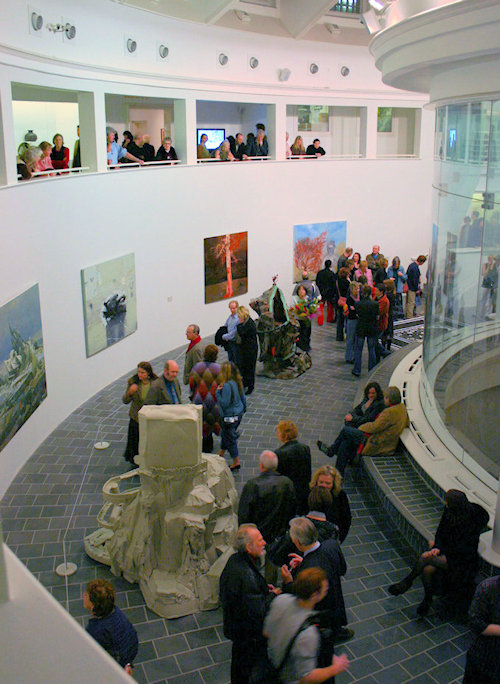
Were you mostly painting portraits, especially of your children, at the time?
When I first came down I was making abstract paintings based on my travels. But when the kids were little I felt the need to respond to that; to my immediate circumstances. And I started using more oil paint. At the time I had a studio above the Exchange. I got that straight away. I was the first person in that building! I met the owner Peter Wood at a party and I bent his ear about it. It meant I was in that building with no-one else in there. It was quite eerie!
So I had this massive studio, and was developing this new way of painting. But every three months I was also going up to London to work as an art technician at the Royal Academy. It was the perfect job. I was meeting curators and conservators from all over the place. We’d be installing ‘Genius of Rome’ or the big Aztec show. I could earn quite good money for two solid weeks, then come back and get on with my work.
It must have been good to be included in that Tate show.
Yes, it was an interesting time. The show seemed to throw down the gauntlet to everyone. It was good in that it provoked interest and debate, but it could never portray all the different strands of activity down here. Some of the best stuff was the site-specific stuff and the artist-led stuff, which wasn’t really represented.
So in a way this led to you putting on that epic ‘Revolver’ show (picture below) which occupied the big PZ gallery space for three months?
I was questioning what was the purpose of making images to sell in galleries. I personally was doing quite well. I was showing in Cornwall and in London, at art fairs and things. It was an exciting time but it was a crossroads for me. I’m glad I did Revolver but had I just concentrated on my own work it might have been better. It distracted me from my own work.
‘Revolver’ was so ambitious.
Once we’d decided to do it, it snowballed out of control! But we met so many brilliant people through doing it. Volker and I wanted it to have the same energy as the artist-led stuff that was happening, but it would be in more of a gallery setting. Work was going up and coming down all the time, so artists got to meet each other. And we wanted to mix up established and graduate artists. We set these principles and tried to push them to the limit.

It was good having graduates involved. You managed to break down the boundaries between different cliques of people.
Without them we would have floundered because they had so much energy. And we asked them to curate shows within it. Louise Thomas is a good example, and now she’s a good friend of mine. I’ve just done a studio exchange with her in Berlin.
But I have some regrets because it put a lot of pressure on me and my family, with financial pressures too. It was getting relentless. After two or three years of financial struggle – three years after Revolver – Sharon and I decided to move to Brighton.
But you were involved in other projects before you went to Brighton…
Yes. In 2008 we did the Revolver book launch and took some of that work up to Bristol. I also got a grant to do ART75. We had an artist in every cubicle of the Penzance Jubilee Lido, with workshops across Cornwall.
In 2009 I did ‘Palmer White’ at the Exchange with Paul Becker who I met at the RA. Then I got some funding from Heritage Lottery to do ‘Possessed Possessions’, which was the beginning of TAap. Sam Bassett had just moved to Cornwall. I liked him and his work, and I asked him if he wanted to join with me, Chris Priest and Richard to see if he’d like to make a body of work to show at the Exchange. I was a bit out of control then. I wanted to throw everything at this project.
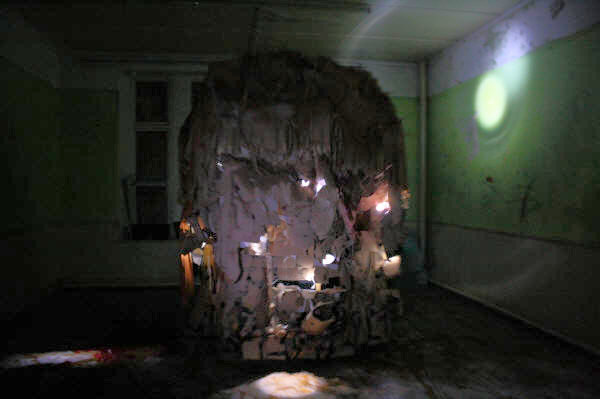
The Newlyn School of Art opened up at around the time I was moving to Brighton. And I was involved with setting up C.A.Z. (Cornwall Autonomous Zone) with Andy Whall, Rebecca Weeks and Ian Whitford. We found a great property and we cleared it out, but I had to tell them I was moving away.
I had about a year in Brighton, but I had a breakdown. I couldn’t cope. I had more of a kinship with Cornwall.
I decided I needed to get away for a while and me and Sharon split up, so I came back down with a view to getting my head together, but things spiralled. I took on loads more stuff. I curated ‘PRINT!, a printmaking show at The Exchange with Bernard (Irwin), then we got a grant from FEAST to do ‘Travelogue Kernow’. PZ Conservation joined with us, to take a bookmaking and printmaking workshop on tour around Cornwall.
Then I met Teresa at CAST in Helston, and put the idea of doing The Dark Rooms (picture right above) to her. She was showing artists around the old school building at CAST to get ideas about how it could be used. I’d met her at the Manifesta talks which she was involved in. CAST was all boarded up at the time, and seeing it was, for me, like a red rag to a bull!
At the same time Sam Bassett had set up Bucca. He was offered the Badcocks Gallery building for it. He was doing it with Henry (Garfit). Sam had just had a baby and there was only so much he could take on, so he asked me to get involved. It ran for 8 months. By the end of it we were selling quite a lot of work. We proved there was a place for selling emerging artists.
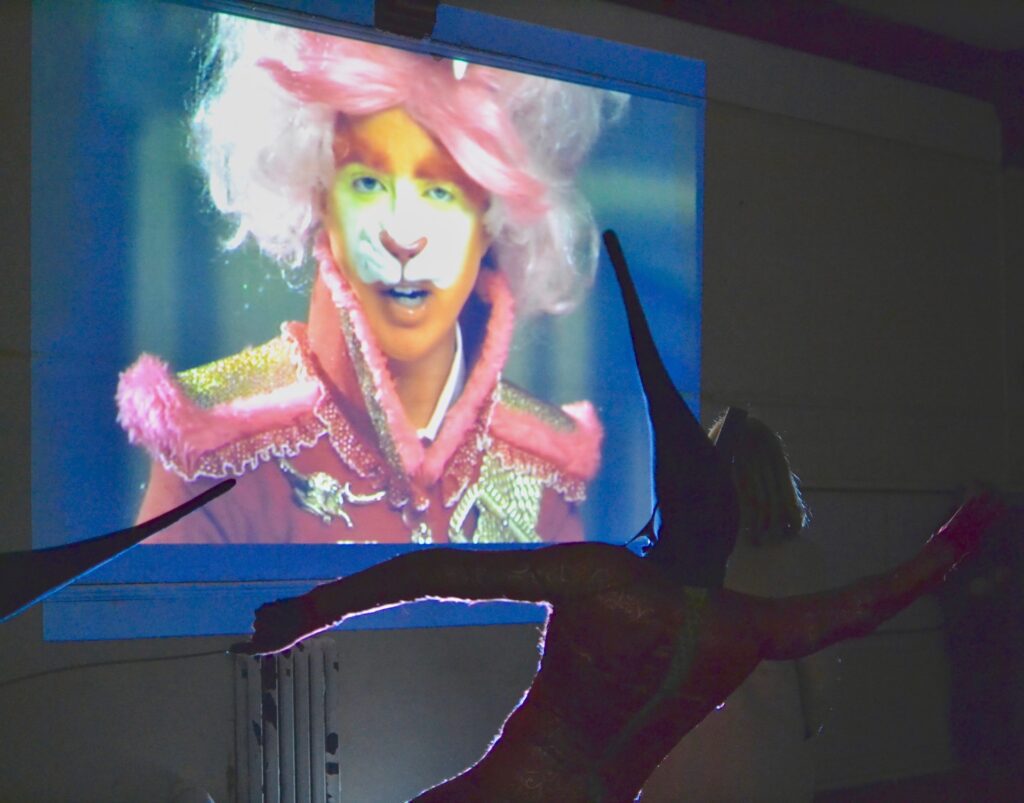
The Dark Rooms was good. Very memorable.
It was very cathartic. It was exciting because this whole building was going to be taken over. But Helston was not on the ‘art-map’ at the time so I thought ‘who is going to come to this?’ But actually more people went to it than if it had been in any other place.
It was over one weekend only, which created an intensity, and even Nick Serota visited…
It’s midway between Falmouth, St Ives and Penzance, which also helped, and Falmouth Uni put on some coaches.
The people involved with CAST didn’t want the locals to feel they’d been invaded by artists. They said ‘we’ve just got to be careful not to upset the community’.
So you couldn’t be too ‘out-there’ or risque?
In the end it was quite out-there, but what saved it was that we had so many artists working there during the week before. They were all buying pasties and buying stuff from the DIY shop. I went to that local ironmongers and he said ‘what’s going on?’ ‘I’ve got a queue of people and all my gaffer tape is gone!’ So he was happy and all the artists were friendly, and that helped break the ice. A lot of the locals came to the show. Many of them had gone to school there.
It was very well done. The idea of using dark space worked well.
I was lucky to have access to quite a lot of artists. I’d just done a residency at Glasgow School of Art. I met two Portuguese artists who showed up there and I met Rachel McLean and we were able to show her film when she was just starting out (picture above). She’s massive now. And we showed some other artists from Glasgow. But also we were able to ask Rosie (Allen) and Cat (Bagg) to curate a show. It was called ‘Parameters of the Dark’ and it was a really good show. Some of the work I’m making now is based on the Dark Rooms work.
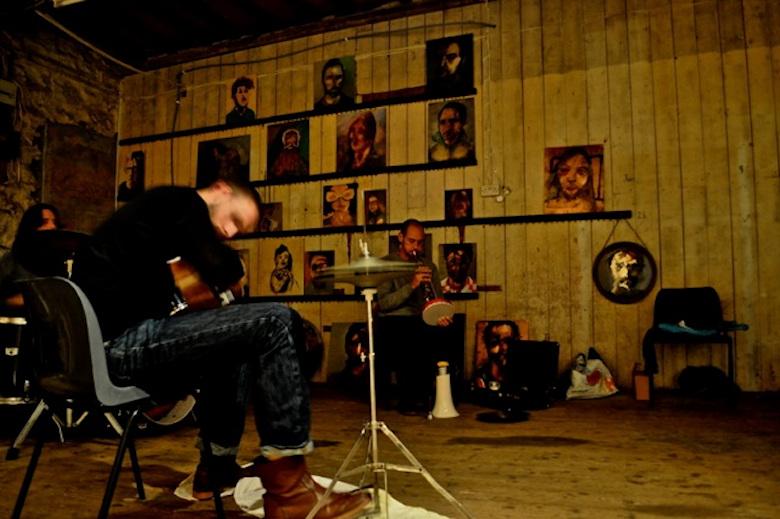
What came after The Dark Rooms?
The Dark Rooms led to me curating the graduate show for Falmouth in London. Then Sam and Joe (Clarke) did ‘Limbo’ in Truro later that year. We did a TAap project for that.
Bucca had lost its space, but we got offered the new cinema space in Newlyn. Me, Mark Spray and Henry (Garfit) did ‘Suspended Sentences’, (picture above) which was responding to the poetry of Simon Armitage.
Armitage was doing a walk around Cornwall at the time.
Yeh. It was a 10 day show with other events, and we got students involved. ‘Suspended Sentences’ helped get the council to make a U-turn on their planning decision. The council had originally prevented the cinema proposal from going ahead, but we were able to get a petition together. That was 2013.
Then I started ‘Picturing the Mines’ with Bernard (Irwin) which included the amazing event ‘Vigil’ at Gwennap Pit (picture below), and I worked towards ‘Unstable Monuments’ with Matt Bennington (second picture below). Again I was seduced by the building in Truro! It was another good show, but I could definitely feel my energy being pulled in too many directions again…
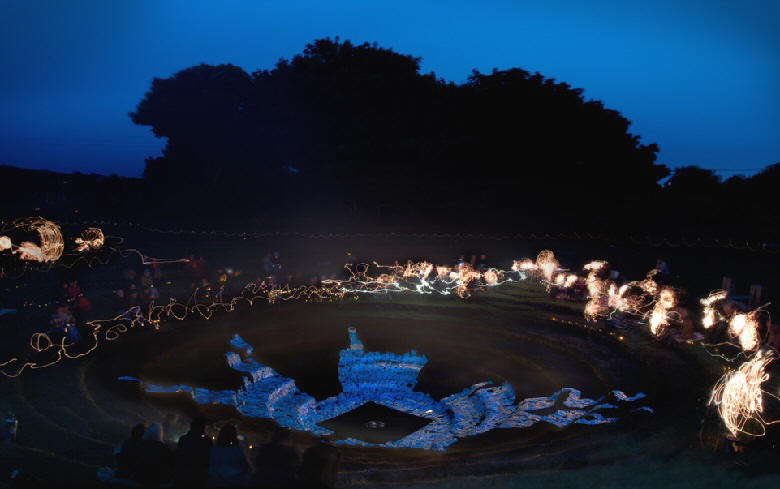
When I got funding from The Arts Council to make my own body of work, I realised I had to really concentrate on that, because during the previous four years, I’d basically been having a breakdown. I’d also done ‘Bronco’s House’ with Mark (Jenkins), but I was sleeping in a van and having to go up to Brighton to see my kids.
I really wanted to get back with Sharon. We all went to Greece. I was there with them on my 50th birthday but I knew I was really broken inside. I came back to Cornwall went to therapy and stopped drinking for a whole year. I didn’t hardly see anyone, and I just went to my studio and painted.
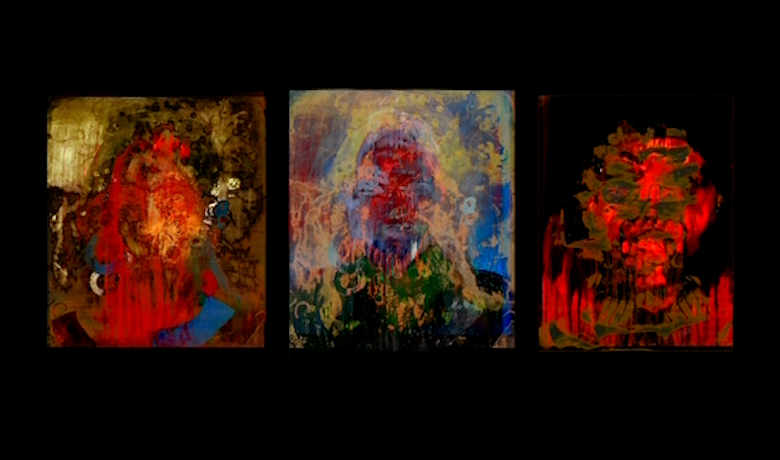
I’m back together with my family now, so I thought the show at Tremenheere would be an opportunity to consolidate and bring everything together and take stock. I’m lucky I’ve got some great friends. The artist community here is great. And the school here in Newlyn. Teaching here and at Falmouth helped me keep it together. Teaching young people helps take you out of yourself.
I realised I really wanted to be with my family. I also decided I needed a mentor. People can really thrive from having that feedback. I wanted someone really impartial, who would challenge me, so I asked Sacha Craddock.
Its what I’ve always needed, because I’ve always been pulled in some many directions. She’s also perfect because she’s so insightful.
Even artists at my age are having to reinvent themselves. Everything has changed in the last 20 years. Artists may show in galleries, but they won’t necessarily be selling. It’s kind of an illusion. Instagram means I sell more work privately, and doing teaching and mentoring. I’ve sold work where I least expect it. Last year Roger (Thorp) and I did a tour across Northern Europe, and we would sell things there. And we didn’t expect to.
So how is preparation for the Tremenheere show going?
I didn’t know I’d be swapping studios so I’ve lost a bit of time doing that. Then last week I had an infection in my knee. I had this dream that my leg was one of those see-through glass hoovers, and it was full of pond-life!
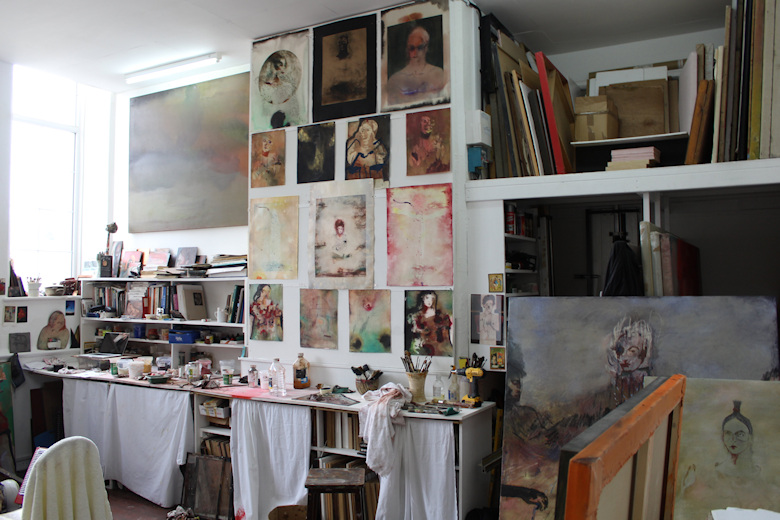
But yeah, its all taking shape, and opening on 25th May. Upstairs there will be a frieze of paintings. They’ll be abstract and figurative. I’m working on about 16 canvasses at the moment. Downstairs there’ll be a dark room where I can show my animations with Roger (Thorp), some collages, collaborations with Sam and TAap and Bernard. It’ll be a montage of stuff from the last few years.
Sacha will come to help curate it. I’m going to enjoy that side of it.
For a closing event – the summer solstice will be on 21st June – I’m asking loads of artists to do a big event in the gardens. It’ll be a fundraiser for Victims of Torture. Neil and Jane (Armstrong) of Tremenheere support the charity, and they’ve given me a free rein. I won’t be overcurating it. I’ll be inviting artists, and then its up to them.
FORCE MAJEURE
“So must one be resigned to being a clock that measures the passage of time, now out of order, now repaired, and whose mechanism generates despair and love as soon as its maker sets it going? Are we to grow used to the idea that every man relives ancient torments, which are all the more profound because they grow comic with repetition?”
Stanislaw Lem, Solaris, 1961
It is early March in Norwich and hail accumulates on the corrugated iron roof of the shed. Seconds later and the drama has dissipated, as ox blood terraced houses and back gardens re-emerge. A Force Majeure can be understood as that which makes it difficult to carry out normal business, the phrase translating from the French for superior force. Force Majeure suggests an unstoppable and disruptive force that halts regular proceedings. In relation to making, curating and painting, we cannot but make associations with the fundamental human urge to fabricate objects and images that help us make sense of the world. When considered in such a way, the urge to make could be problematic, or when viewed from another perspective, a catalyst for change.
The figure has been the consistent subject matter for Smith’s work, and the works constituting Force Majeure are no exception. The figures within this body of work range from individuals he knows well, such as family members and friends, to musicians who have influenced him. Inherent within the act of painting portraits, especially with those of subjects not known, is the notion of the gift, an offering made in the spirit of sympathetic magic: an expression of gratitude made in exchange for the impact of the given work upon the artist.
Aspects of the paintings have been co-authored with his son Caleb, an arrangement which subverts traditional mentor/pupil relations. We are left to imagine the preceding dialogues between Father and Son, with the question of who has painted what left for us to speculate upon. The name Caleb refers to John Steinbeck’s East of Eden, the story of two brothers and one (Caleb’s) blighted struggles to gain his father’s approval. In the novel we are witness to the ensuing acts of destruction when Caleb’s efforts are rebuked, with acceptance coming only at the end of his father’s life. Here we can be reminded of the German legal definition of the phrase Force Majeure, where ‘liability persists in the face of default by a debtor.’ We have debts of responsibility to our children and our loved ones, and the act of painting them, and making things with them is a means of maintaining contact, and focusing thoughts. Historically the generation of Ikons can be seen as an attempt to bring the heavens closer; in this instant it is a means of venerating those who are not always present. In 15th century Norway votive ships were constructed and hung in coastal churches to focus prayer on the vessels and loved ones currently at sea. Nearness in spite of distance. No ritual without myth.
‘Chopin’s Vigil – we mash up the place’ is reminiscent of a Hyronimous Bosch painting in its depiction of numerous small scenes in a broader composition. It differs from Bosch in the fact that the ground of the canvas doesn’t detail a particular locale, rather it is washed out and indeterminate. The contents of the islands of figurative imagery within the painting refer to a set of personal mythologies, stories written and enacted in landscapes with family members and friends. The simultaneous representation of numerous time frames and events in a single surface affirms that, for Smith, the past both exists in and informs the present.
In an increasingly secular society rituals gradually recede from our collective memory. Whilst many European cultures are often keen to lament the loss of rituals from afar, romanticising ‘the Other’, many indigenous cultures conversely welcome change. The interpretation of received wisdom and the production of new myths and rituals is vital for renewing the expansion of our cultural landscape. As a writer and friend of Jesse, I have encountered his rituals through storytelling and witnessing them in person, etching them into my memory, inspiring me to generate my own. Rather than list them, perhaps it is more in the spirit of participation that the viewer look at the work in the show with the enjoyable task of discerning or reenacting the rituals alluded to in the work; doubtless interpretation will differ from original intention.
The strength of the painting resides in the fact that the marks retain the fluid spontaneous quality of drawings, sketches and maquettes. Frequently the face is conceived as a line based structure, revealing aspects of the seemingly incidentally stained canvas through it: structure and chaos. Figures are coerced out of smears of paint. They are depicted both alone, and in group dynamics. When alone the vast scale of a face fills the canvas, like a projection onto a landscape. In the paintings of grouped figures the smaller scale of the subjects, and their dynamic with one another, suggest a state of languid repose with one another.
Trusting in the act of making anything without reserve galvanises the maker and is infectious to anyone who participates or co-authors that act. I first met Jesse in 2010 upon my graduation from Falmouth University, a year later and I was showing work in a wheezing, juggernaut of an Arts Council supported exhibition alongside 40 other artists that Smith was curating in a derelict Victorian art School, in Helston, now CAST. The etymology of the verb curate refers to the act of caring for something, an almost impossible task when parts of the building you have chosen to work in are collapsing, and yet care remained. Moving towards such demanding curatorial endeavours is analogous to moving into the direction of a coming Force Majeure; a need to dispel the comforts of the known experience in favour of the new.
Matthew Benington
JESSE LEROY SMITH: FORCE MAJEURE

In anticipation of his forthcoming exhibition in the impressive, oak framed Tremenheere Gallery I have been fortunate enough to see some of the ongoing developments in Jesse Leroy Smith’s recent painting practice. The final selection, overseen by independent art critic Sacha Craddock as curatorial advisor, promises to be rich in imagery and content.
On the artist’s Instagram feed in the run up to the show we read that visitors will experience an “Immersive frieze of paintings across both gallery floors with (an) arcade of collages, photographs, drawings and prints.”
This selection of work draws upon a decade of experimental projects, which is apt as I was first introduced to Leroy Smith’s paintings, prints and drawings about nine years ago when we were both participating (separately) in a Brighton Festival event. My first impressions of his work were two-fold, with the most immediate visceral impact being for the powerful visual presence of the mainly portrait imagery developed from observations of his two children. These I found discomfortingly transgressive in the sense of looking and feeling both human and idol-like, as if to undermine notions of pure individuality or sedate portraiture. The portraits were not necessarily of the children so much as from their lives. Physical poses, looks and gestures transformed them from individuals to archetypes, for in those early years life has an imaginative and theatrical edge constructed through play and enhanced with costume.

The other impression had less to do with the immediate impact of the image (though essential to it) but was one of great admiration for his application of drawing skills. I recall thinking that, unusually for many contemporary figurative painters, here is someone who can draw within the painting – that is within the methodology of the practice, assuredly and authentically aligned to concept and execution. Undoubtedly the talent to make a mark intentionally, especially with a difficult medium like paint, relies as much on the artist’s psychic experience as of the result of an academic educational training. The manual nuances of painting, and drawing and printmaking, in Leroy Smith’s work encompass qualities of a physical and visual confrontation with the visual subject as both materiality (e.g. see how the paint behaves) and mark (painterliness and linear qualities evincing shape as form). The weak images made by so many others rely on look alone and are ethically redundant. Not so here, for in the latter stages of ‘Force Majeure’, as an unplanned project relating to real life circumstances, it appears that this ability to develop the potency of the figurative image persists, with a rawness exploited to the point of near destruction in the drawing content. Empirically, if this is not a contradiction, Leroy Smith reveals the facts of the imagination.
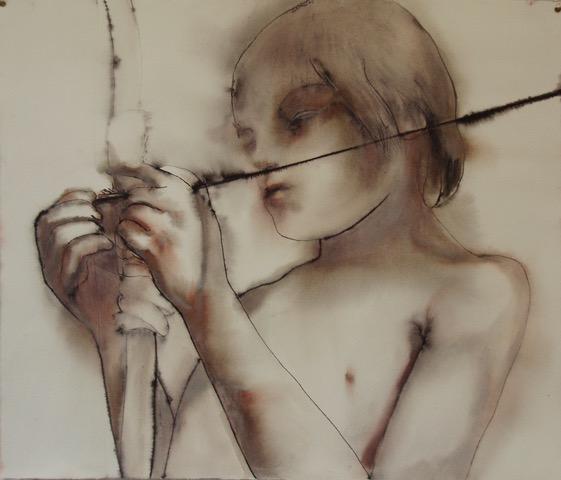
The two standard definitions of the term force majeure can be compounded into one seemingly paradoxical interpretation by this exhibition. For unforeseeable circumstances that prevent someone from fulfilling a contract, and/or utilising irresistible compulsion or superior strength, might be summarised by a well-worn cliché: from adversity comes strength. Despite the trials and tribulations of juggling relationships, purposeful endeavor, and self-worth, the results are impressive and uplifting.
An individual’s circumstances are personal, but the consequences and reactions to adversity have an impact that operates on (and with) one’s immediate family and friends, or in the case of creative outlets, can be transformed into the relevant art form. With compulsion, a veritable strength if channeled positively, generates, creates and realises ambition. If there is one thing an artist needs it is strength in commitment to image making and to finding a voice that speaks truths, however confused, damning and disheartening at times.

Interestingly, in a discussion with artist and writer Paul Becker, Leroy Smith has explained that the main focus of the show, a frieze of up to 18 paintings, his ten-year retrospective is a form of apologia:
“As a parent, son, friend, lover, teacher we fail. Let alone the environment. This frieze is an attempt to makes sense of how we can’t cope with being human. For me, painting is a medium of doubt and speculation, what is smeared away is the potential exhilaration.”
Doubt and speculation… these states of being can haunt us all, especially when attempting to progress and develop ideas and to finding meaning through our visual arts practice. In the most recent imagery of the frieze we see many figures, often in a state of becoming or disintegration. If you have followed Leroy Smith’s development this is not necessarily a new development for the individual figure, especially in his impressive range of portraiture over the years. But here the scenarios feel speculative, as the surrounding landscapes expand to a more dissonant environmental space that could be read as dystopian. I prefer to regard these spaces as potentially mythological (echoing and reviving the past) or even futuristic, where lessons might be learned. The sense of time is Bergsonian rather than Cartesian: mobile and fluid, impossible to measure and avoiding an exegesis of fully-fledged facts alone that might induce stasis. A cinematic quality pervades the frieze imagery that induces a sense of an unraveling of time without conclusive certainty – such is the experience of real life.
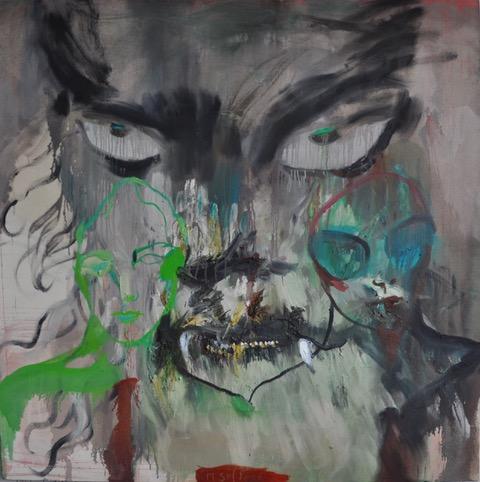
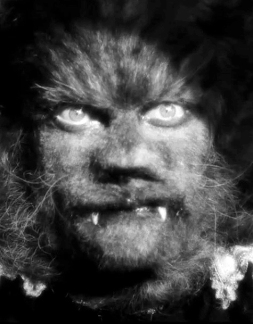 The imagery is very open to interpretation. For example, in one panel the father-like figure could be a form of self-portrait (for the male painter) or a fictionalized ‘other’. Or perhaps acknowledges a loss of one’s own childhood for the responsibilities of adulthood. Alternatively, on a mythological level, is the monstrous, colourless, male figure the Bogey Man (or the Green Man) lurking both in the subconscious and in the forest? Or is this a Greek god: Apollo, Ares, Dionysus or Hermes? When I checked with the artist he revealed that the character is transcribed from Jean Cocteau’s 1946 film, ‘La Belle et la Bête’ (Beauty and the Beast). From the IMDb trailer the epic lines: “Love can turn a man into a beast… Love can also make an ugly man beautiful”, add poignancy to looking again at Leroy Smith’s images. Certainly, the imagery from his paintings, prints and drawings continue an exploration of the poetics of the visual, where the formal and material qualities of the imagery subsume a narrative that is purposefully open to interpretation at a gut level. How else does one react to a mise en scène of psychological disintegration and ongoing, redemptive recovery? Might this exhibition represent a healthy period of change and of development – despite the sometimes fractured topology, where disembodied arms and lips, or the split-faced, mask-like vestiges inhabit these works?
The imagery is very open to interpretation. For example, in one panel the father-like figure could be a form of self-portrait (for the male painter) or a fictionalized ‘other’. Or perhaps acknowledges a loss of one’s own childhood for the responsibilities of adulthood. Alternatively, on a mythological level, is the monstrous, colourless, male figure the Bogey Man (or the Green Man) lurking both in the subconscious and in the forest? Or is this a Greek god: Apollo, Ares, Dionysus or Hermes? When I checked with the artist he revealed that the character is transcribed from Jean Cocteau’s 1946 film, ‘La Belle et la Bête’ (Beauty and the Beast). From the IMDb trailer the epic lines: “Love can turn a man into a beast… Love can also make an ugly man beautiful”, add poignancy to looking again at Leroy Smith’s images. Certainly, the imagery from his paintings, prints and drawings continue an exploration of the poetics of the visual, where the formal and material qualities of the imagery subsume a narrative that is purposefully open to interpretation at a gut level. How else does one react to a mise en scène of psychological disintegration and ongoing, redemptive recovery? Might this exhibition represent a healthy period of change and of development – despite the sometimes fractured topology, where disembodied arms and lips, or the split-faced, mask-like vestiges inhabit these works?
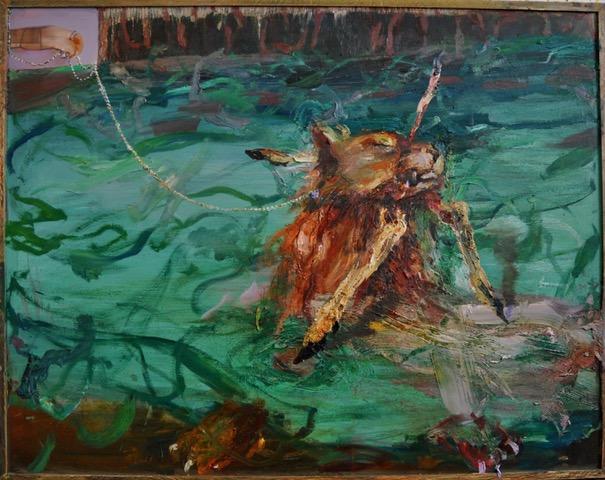
And what of the animal parts? A bird’s head, a dog (domestic or wild, it may not matter), a pig, bears. We share this planet after all, despite our tendency to consider the world our own in anthropomorphic delusion. Soulful feeling is surely dispersed into all living things and the latent animism, however dispersed and distressed, envelops us all. Because all the world is (really not) a stage.
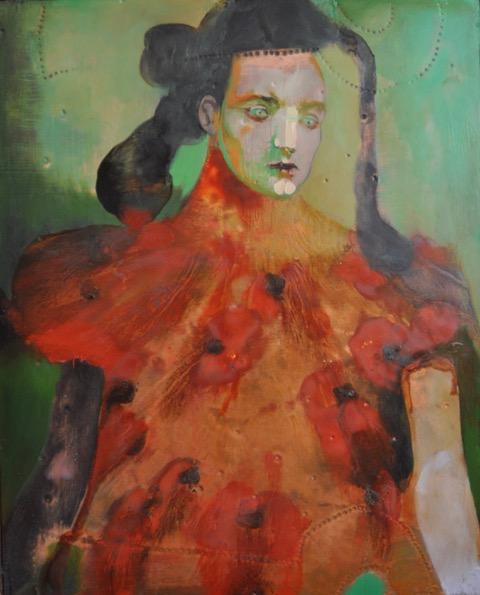
On a practical level, especially when considering the paintings, the medium is applied confidently, often generously but not necessarily thickly (though sometimes it is) but skillfully allowing the medium its own characteristics. This could be the flowing nature of thinned oils or an area of sticky mastication. Colour is as crucial as the linear/drawing content. Sometimes brash, though often subtle in effect, the colour creates the mood of spaces. Environments are liminal, characters pensive and ruminatory, though clearly part of the space and therefore the unfolding story. Literal, physical surfaces are visceral, compounding the mood. There is a confident interplay between the illustrative image and the qualities of the substance, its shapes, forms, tone and colour.
The sequencing of a frieze references storytelling of course, and from our Greek and Roman cultural heritage great stories and events are made public. In a modern context there is something of the poster too, whereby the format and sequencing of a display of paintings also becomes public in the gallery environment. But whereas the commercial poster is designed to clearly communicate, influence and bring attention to some circumstance or to graphically convey information, the richness of the narrative painting tradition insists on far more prolonged contemplation to enter the depths of novelistic truths and mythologies. The mystery must be shrouded in plain sight – must be emotional and experiential.
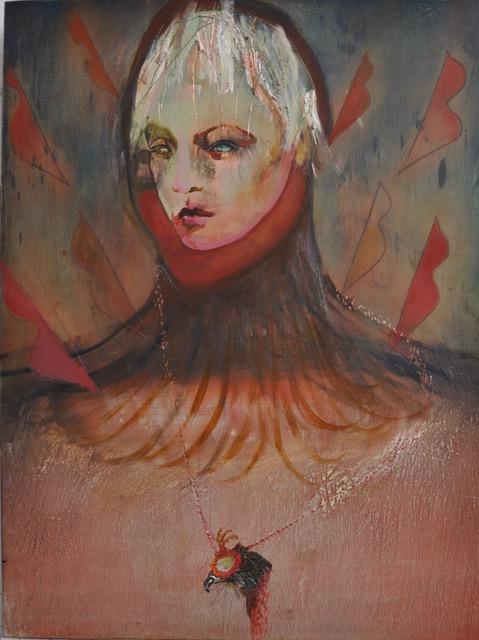
Despite reflecting on personal upheaval over a ten-year period, Leroy Smith’s paintings appear to be in a state of becoming, as opposed to the fragmented and unresolved. Contrary to a notion of personal or cultural history compromised by circumstances, change is the nature of things (and events). There can be, and is, a sense of the transitional within completed compositions. If a figure or an environment in his paintings sometimes appears piecemeal we might read this as necessary shorthand, implying a sense of time and a developing narrative despite the retrospective nature of ‘Force Majeure’.
Jesse Leroy Smith’s images appear to be found through the process of making the work, rather than pre-planned. There is also something of the theatre and the cinema about the scenarios, whereby we can safely relate if viewing from a distance, outside of events. We might all connect with sometimes playful, or challenging, imagery of relationships with others and ourselves and with accepted or expected norms that are ideal more than actual. These various narratives may not be exclusively social or familial worlds but are also shared, universal, psychological constructs. It is in the nature of truly contemporaneous art, that it constantly revives itself in and for the present and through the eyes of the beholder. This explains the over-arching humanity and relevance of art from all eras. ‘Force Majeure’ promises to be a blockbuster.

Geoff Hands 2019
Links:
Jesse Leroy Smith
http://www.jesseleroysmith.com
Instagram – @jesseleroy66
Tremenheere Gallery
Sacha Craddock
Paul Becker
https://paulbecker1.xhbtr.com/THEKINKINTHEARC
IMDb – La Belle et la Bête
https://www.imdb.com/title/tt0038348/videoplayer/vi1008515097?ref_=vp_pl_1
Talking art, life, and being buried overnight, with outsider artist…

In art, inspiration comes from many places. Nature, love, trauma, the face you can’t forget. Look, see, make: the standard one, two, three. For Jesse Leroy Smith – painter, curator and collaborator – the search for inspiration takes him one step further: making experiences in order to make art. Be it wearing a pumpkin head, buried overnight or showing the work of an invented artist, these experiences – otherworldly, ritualistic, outsider – are designed to feed his painting. Like a vampire feeding on his own blood.
But only partly, because as much as he likes to paint, Smith’s fascination with the old, the very rural, the lives of compulsive makers, comes from – and returns to – a love for being with people, people leading different lives, lives lived at the very edges of so-called normal living. Hence leaving London. Hence Cornwall. And hence a propensity for putting on shows that are as much about the experience of being at a show as they are the art being shown. Party on. Wildly.
A big fan of the naive, of making mistakes, of failure, Smith consistently, as artist, curator or collaborator, speaks in the voice of a specific type of community, one that is here and gone, a community of magic makers, a community that is ribald, staggering, drunk on itself, on oddness, on its ability to make things happen just because they should. In short, he’s the real deal, a rare bird. No doubt.

I believe you spent a night buried in your garden; and that a friend burnt a tree on top of your burial mound. What was that about?
Maybe to remember how it is to be 24. It started with a visit to an ancient underground city in Turkey, out of tourist season. A guard slept at the ticket kiosk amongst cans and cigs, so we sneaked past and I went down 9 storeys. But the lights went out – the guard must have woken up – and after the initial wonder at absolute darkness and silence, I panicked as I couldn’t find my way out. After much clawing, I shot out of there. The surface of the earth was bleached in light and life. I felt completely alive.
When I returned to London, I worked in my garden and local forest using fire, earth, glass, debris and such like. I had always painted, but this seemed the best way to explore my travel experiences. I made a kind of open den. I had a dream that I was underneath this plot. I decided to re-enact the dream. So, after going through about 2 ft of black earth, I dug a telephone box size hole, braced and carefully carved into the sand earth. There had been a storm. A cherry tree had fallen. I piled it up – from logs to twigs, as you sometimes see in mountains shacks. You can get a lot of joy from such things. I built a kind of tent from the branches to surround the hole.
That night, I climbed in. A friend lowered a trapdoor and the 2ft of black earth. He then burnt the wood over the night. At dawn, light came down the scaffold poles that I used to breathe. When all the wood was burnt he swept up the ash and dug me out. The January earth was steaming. We set fire to the tent and drank the last of the brandy.
Why did I do it? To me it was a lot about the absolute trust I had in my friend. Christ’s mates fell asleep. Mine didn’t. He was a great friend, but I don’t know where he is now.
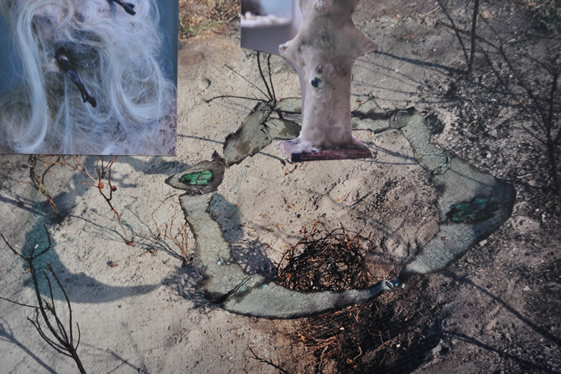
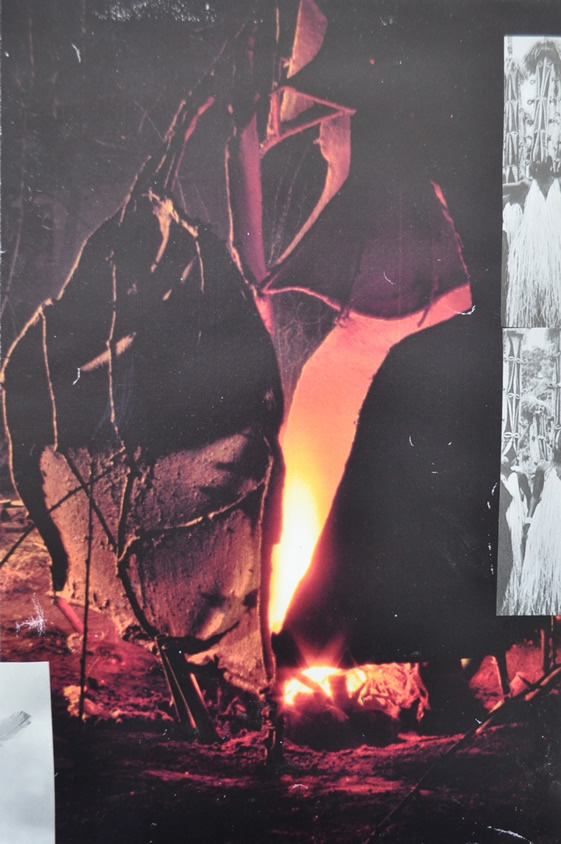
A great deal of your life as a working artist was – and still is – spent in Cornwall. The place is positively jumping with painters, sculptors and the like. What is it about Cornwall that so get’s artists going?
It’s like an island in many ways, with such varied coastline. The further west you go, the more you make a commitment to a different life, and that’s where you get so many artists. Britain has many stunning landscapes – also known for their ancient and pagan legacies -but it’s very rare to have such a succession of so many artists visiting and living in such a rural place. Not all are concerned with the land, but it is interesting to see how art is made outside of the cities. It always seems there is a potential that will click there, but it never quite does, and maybe that is what saves it. It’s not really behind the times, but it is bohemian, so it offers a kind of alternative to modern lifestyle. You can have a damn good social life there – quite unusual in the UK countryside.
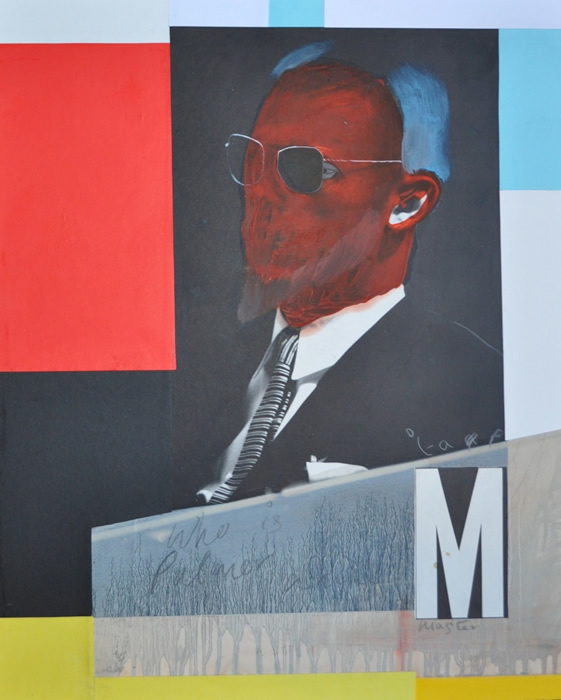
Who is Palmer White?
Palmer White’s work was a revelation to me. It was and is an example of something you could only get in Cornwall: a direct response to a raw and primal landscape.
After years of discussing ritual and ancient art with my artist friend, Paul Becker, we managed to track down Palmer’s work. We started to discover his subtle interactions in the landscape around Penzance. We thought of them as Revenants – as he seemed to be concerned with the death of the land. They often portrayed a malevolent force, and sometimes a protective guide. A face painted in mud on a mirror left in a tree at night, or tiny monk-like heads amongst mushrooms. We were so excited, and devoted our time to searching caves and remote moors. He became a source of wonder. His work made us really study nature; it made us consider the obligations and purposes of his art and actions. So we started making performances, costumed dances in honour and in response to him. We built up quite an archive and decided to show it recently in Cornwall.
Palmer White exemplifies all that I love about so-called outsider artists. If he didn’t exist we would’ve had to invent him.
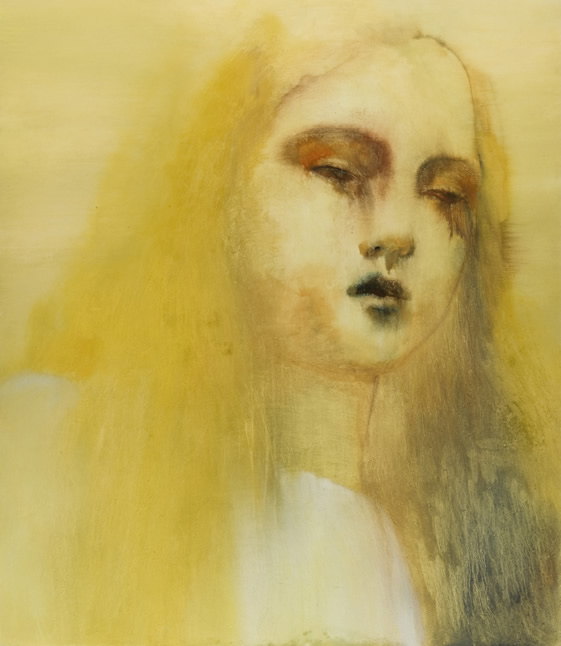
As well as create, you curate. Some of your most recent shows include the hugely successful Revolver project, and ART75, and PRINT ! I know they took a lot of doing. Tell us a little bit about each, and why you got involved.
In 2007 – with another artist friend Volker Stox – we got access to an ex-car showroom on Penzance seafront and decided to stage a series of shows and events within 6 weeks called Revolver. Every Friday we had a big party to open a new show and we were able to show over 60 artists, graduate to established, local to international. Large scale and spontaneous works like video projections, installations and such like could be shown and documented. The emphasis was placed on having a really good time. It generated a lot of new work and friendships. We then published Revolver as a portrait of what was going on then.
The joy of Revolver seduced me into staging similar sprawling events. ART 75 was the anniversary of the art deco lido in Penzance. Together with Richard Ballinger, we asked 75 artists to use the 75 cubicles for installations, films, sculptures etc. We had performances, bands, synchronised swimming and workshops.
PRINT! I did last year with Bernard Irwin. Alongside the works of historical and renowned artists, we had a printmaking workshop – located at the heart of the space – and artists and the public made posters, books and prints throughout the 3 month show. By bringing such diverse people together to share ideas and skills it becomes so much more than a show.
Shows are incredible. The main obstacle is getting access and permission. Once you do, then the public and community unleash overwhelming generosity and energy. Society is so ordered now, and the art world is no different: art schools, galleries and art fairs tend to be quite dry, conformist and serious.
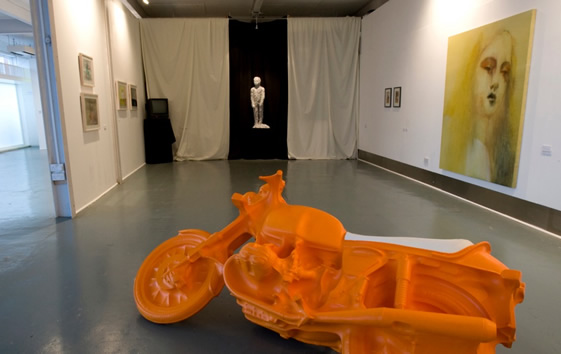

Over the years you’ve collaborated with all sorts of people, including your own family. One of your most fruitful partnerships has been TAAP, a small group of similarly minded artists. How did TAAP begin, evolve, and what – if anything – is the group working on now?
I asked a group of artists to make the show Possessed Possessions after Xmas 2010, and work together in my studio. No one was making any money and the vast studio I had and loved had to go, so this became a swan song to it. Most of our lives were imploding in many ways and this provided a rich compost of ideas. We made sculptures, films, performances and fashion shows – and kept trying to humour and surprise each other. We held the evening Silver Screen Séance, which celebrated the extent of our joy and failures.
I really think it’s important to create landmark times in your life – when you can say that couldn’t happen again, but was wonderful. Collaborating is a great way to make great friendships. I also asked my kids to help on the Palmer White search and it was a remarkable way to spend time together. And we stole all their ideas.
Taap is a very different beast now, we are all nearly rejuvenated. Three of us meditate like we have just found painting, but that practice is about trying to move forward. We’ve just had a show of one off posters based on our love of the tradition. These started by de-facing drawings and paintings of mine – work I couldn’t bear to burn or exhibit. They drew all over them, tore them in half and we made up scenarios about the new characters that arose.
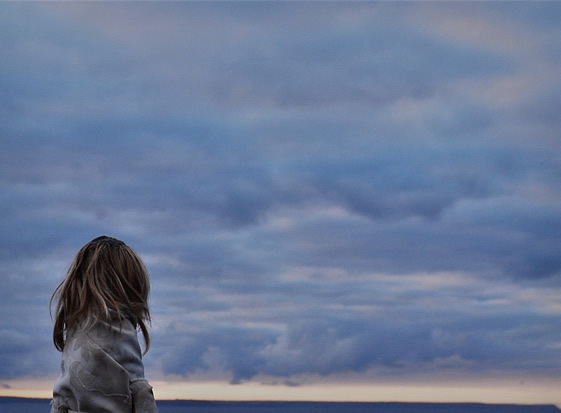
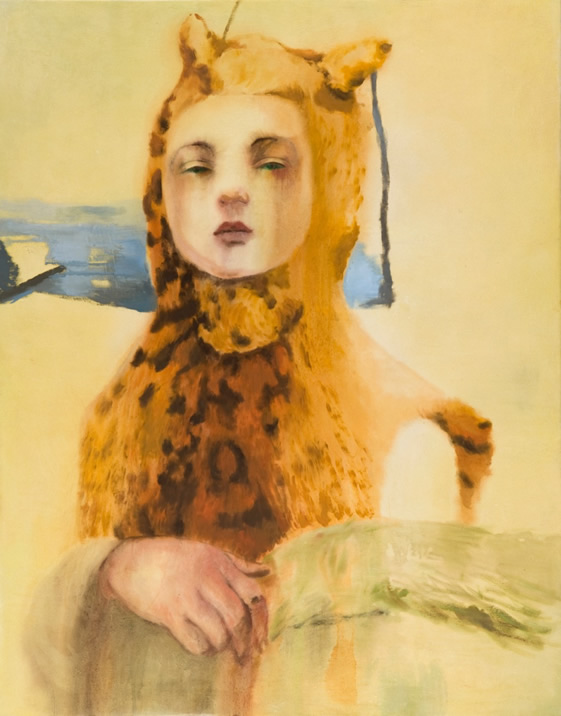
In the end, despite the collaborations, the sculpture and print work, you’re a painter. How does everything you do relate to painting? And what is it about painting that makes you so want to paint?
I ‘m hoping that all the projects I’ve done recently will feed into a different way of painting. I’ve made some good paintings, but I have always been frustrated by not being able to include all the stuff I’m interested in. I think now I will paint in a kind of collage way.
Looking at great paintings is like the thrill of painting itself: whilst you can be overwhelmed, it’s often very subtle; you may look at it for just a few moments, but it is enduring. You know… Like childhood memories are usually incidental, like the wall at school or all the dog shit in the alley on the way to church with my nana. Painting is often about that stuff – as a vehicle for all other human experiences. The activity of painting is like meditating. You forget why you’re doing it.
Over the last few years I’ve been collating scrap books, with images from all sources. From these, I want to make my new paintings embracing all influences and experiences. I have many large paintings stored in Penzance. They vary in quality, and I can’t keep all of them, so I will be painting into them, collaging and may ask friends to add their mark. It will be like collaborating with my former self. I’m looking forward to our chats.
John Harvey is a Novelist, poet, dramatist and sometime publisher. He is a collector of my work including the painting ‘Toy Gun’ seen below.
See www.mellotone.co.uk and his Blog – www.straight75nochaser.wordpress.com
… It is the children I come back to – the children who, again and again, come back to me. The sketches in pen and ink that capture a moment, life – lives, real lives – in a stroke, so fast the pen can scarce have left the page.
But it’s the paintings that haunt, that draw you back, paintings like “Idol” where the subject seems to have become a ghost of her very self; the blue mouth redolent of drowning, the red unfocused eyes with their suggestion of both blood and tears. Vulnerability. Strength. Hurt.
The spaces that surround these works draw you in, invite you to fill in the edges, harden contours, construct lives, at the same time that their fluidity and almost amorphous surface denies any wish to pin them down, to fully understand.
These are Henry James’ Innocents, J. M. Barrie’s Lost Boys. They live within sight yet out of reach. Paint over the canvas, white it out, and they would still be there, the merest trace, waiting to rise up again at the touch of a brush.
John Harvey
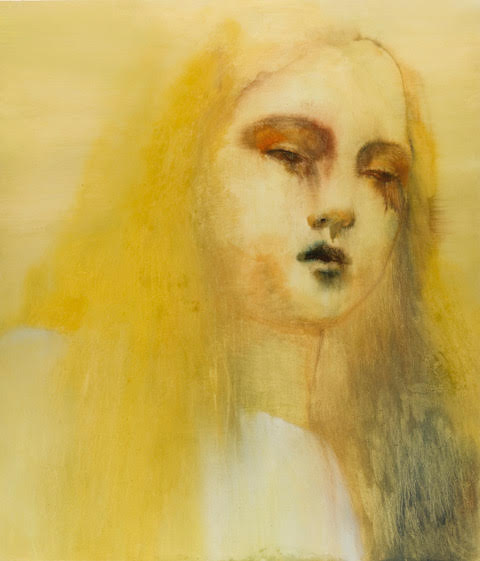
Jesse Leroy Smith – ‘Idol’ – oil on canvas lined panel – 180cm x 140cm
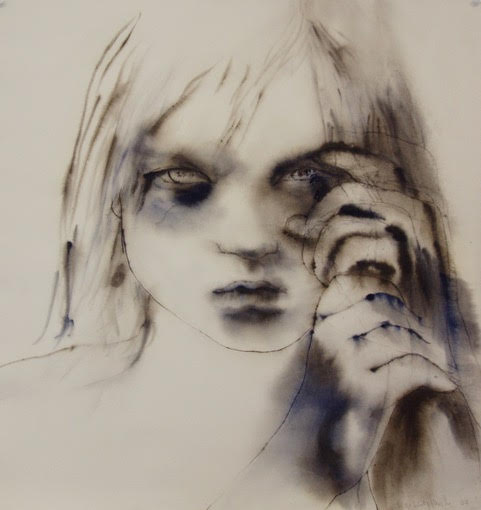
Jesse Leroy Smith – ‘Mascara’ – watercolour and ink on paper – 90cm x 80cm, Private Collection
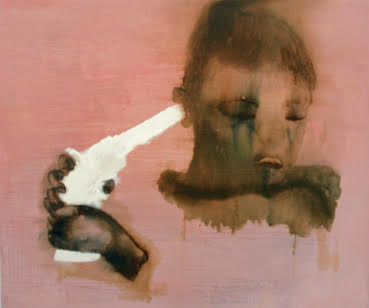
Jesse Leroy Smith – ‘Toy gun’ – 122cm x 102cm – oil on panel – Private Collection
By Paul Becker – Artist, Writer and Musician
Instagram – @mrpaulbecker Paul Becker (@mrpaulbecker) • Instagram photos and videos
The Kink in the Arc – Writings
A child puts its fingers to its mouth and pulls on two cigarettes like pan pipes. Another rests a toy gun against its temple. I keep thinking of childhood as some form of atavistic madness, but do these figures represent children at all? They seem more aligned to the natural world than they do to the purely human. Some are dressed in animal skins or hunker down amongst dogs. Each mordant image is permeated with the feeling that, just like amid the pirates in “A High Wind in Jamaica” or on the island in “Lord of the Flies”, the usual set of rules don’t apply.
“Maybe there is no beast…maybe it’s only us.” 1.
The world is sampled for the first time (snail, flower, window) but it feels like the same slightly weird way tyro acid trippers can stare for an hour at one of their hands. I am always shocked to remember the images are almost all refined from worked–up drawings, and prints. An image is favoured and repeated until the movements of its making are familiar, almost bravura. When Jesse gets on a roll, one has the feeling the most timeless images he makes are producing their own heat. Pulled out of the fire and duly burned on the retina.
1 .From “The Lord of the Flies” by William Golding.
‘She had been playing houses in a nook right in the bows, behind the windlass ( on which she had hung a devil’s- claw as a door knocker) ; and tiring of it was walking rather aimlessly aft, thinking vaguely about some bees and a fairy queen, when it suddenly flashed into her mind that she was she. She stopped dead, and began looking over all of her person which came within the range of eyes. She could not see much, except a fore-shortened view if her frock, and her hands when she lifted them for inspection; but it was enough for her to form a rough idea of the little body she suddenly realized to be hers.’
From ‘A High Wind in Jamaica’ by Richard Hughes
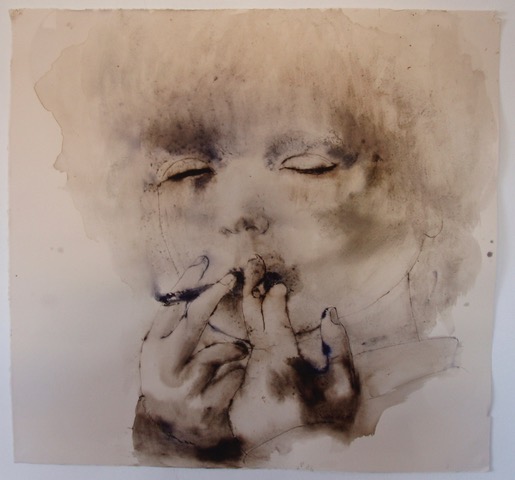
‘Smoke’ – Watercolour on paper, 80 x 80 cm. Private Collection
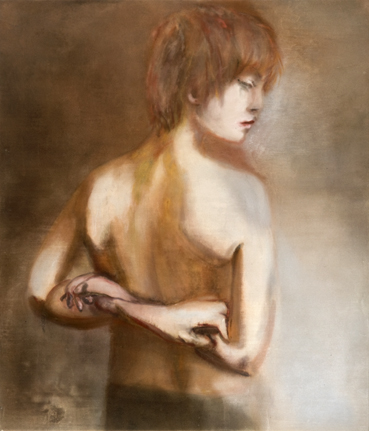
‘Kicks’ – Oil on canvas lined panel, 150cm x 120cm. Private Collection
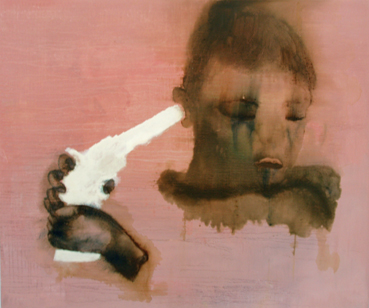
‘Toy gun’ – Oil on panel, 122cm x 102 cm. Private Collection
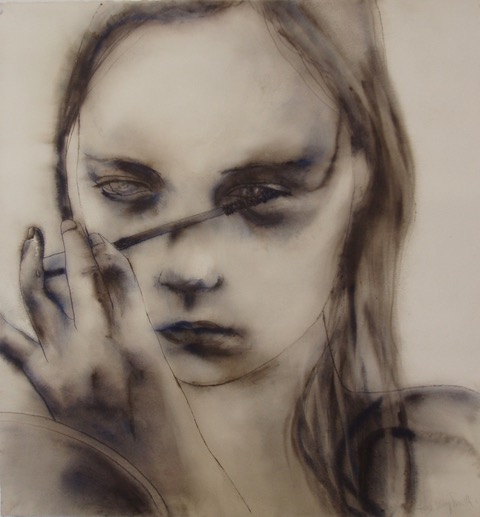
‘Mascara’ – Watercolour on Paper, 70cm x 73 cm. Private Collection
Working with Jesse taught me a very great deal about myself as an artist, especially regarding the possibility that making artworks can be both incredibly serious and deeply hilarious at the same time. It made me realise that artists are really good at half knowing, at trying really hard to talk about difficult things and how important it is that their honest failures to do so are incorporated into their methodologies. That the idea of virtuosity, technical mastery of materials is mostly a dubious understanding of the origins of art practice.
My idea of the landscape completely shifted as did my notion of my own work. It was the first time either of us had worked collaboratively and because Jesse was so generous in that regard and already a trusted friend, I think it moved both our thinking on and allowed us to ditch a lot of tired, sorry-assed notions of the lone genius. For me it facilitated a crucial engagement with the fictive/the imaginary, with writing as artwork and the idea of one art practice containing another: an expanded version of Ekphrasis.
by Paul Becker
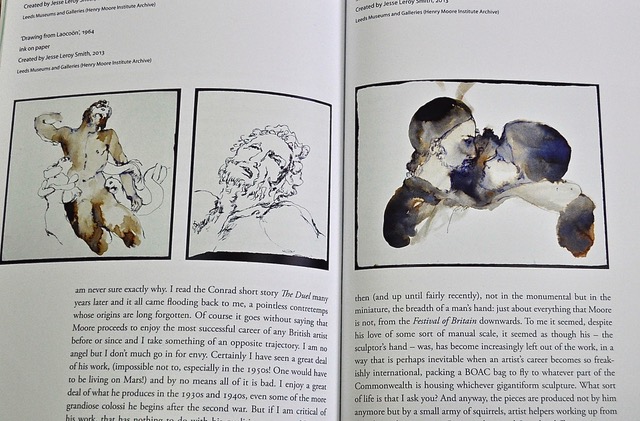
‘Anton Lesserman’ by Paul Becker . Drawings created by Jesse Leroy Smith

‘Anton Lesserman’ by Paul Becker . Drawings created by Jesse Leroy Smith
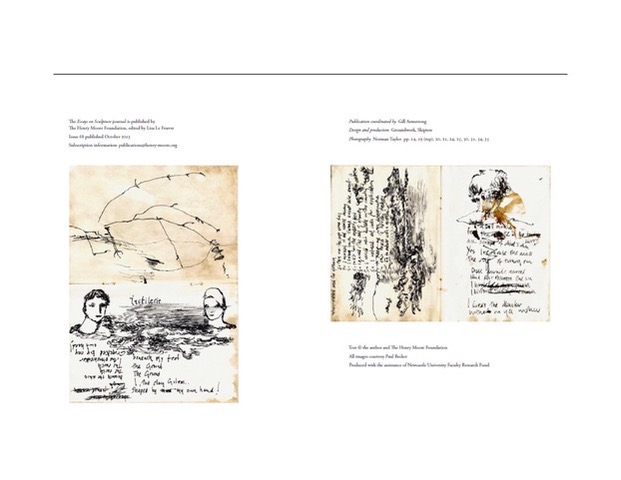
‘Anton Lesserman’ by Paul Becker . Drawings created by Jesse Leroy Smith
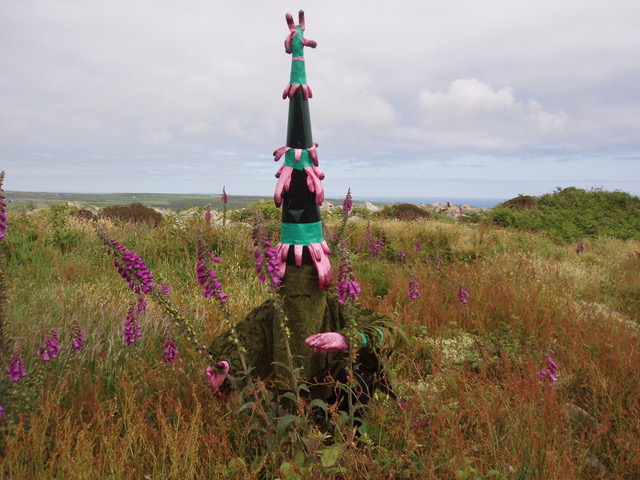
‘Revenant in Madron’ from Palmer White projects – Jesse Leroy Smith with Paul Becker- photo by Sethe Smith
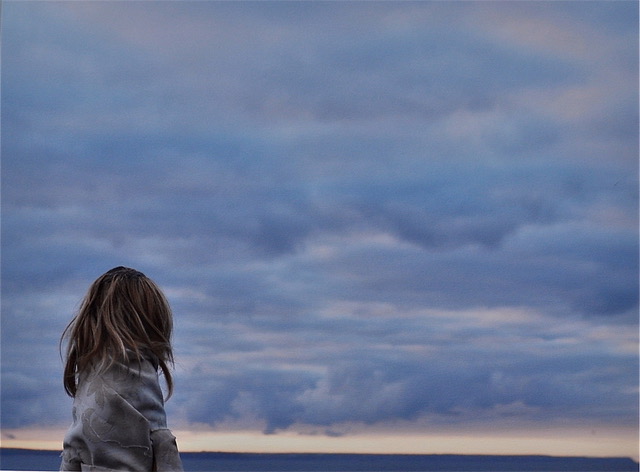
‘Revenant, Prussia Cove’ from Palmer White project – Jesse Leroy Smith with Paul Becker
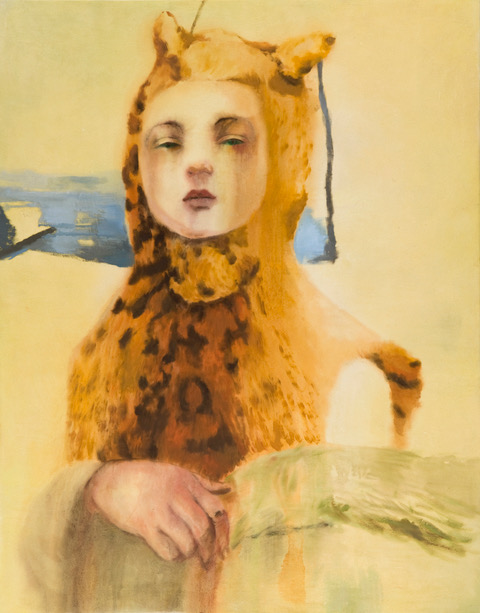
‘Leopard’ – oil on canvas lined panel – 178cm x 132cm
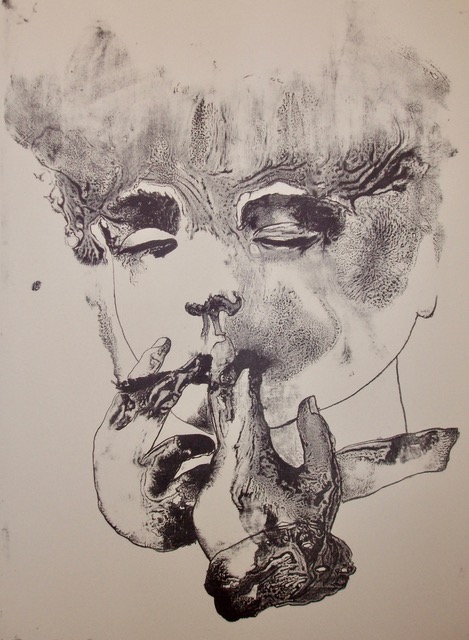
‘Smoke’ – Lithograph – 72cm x 60cm
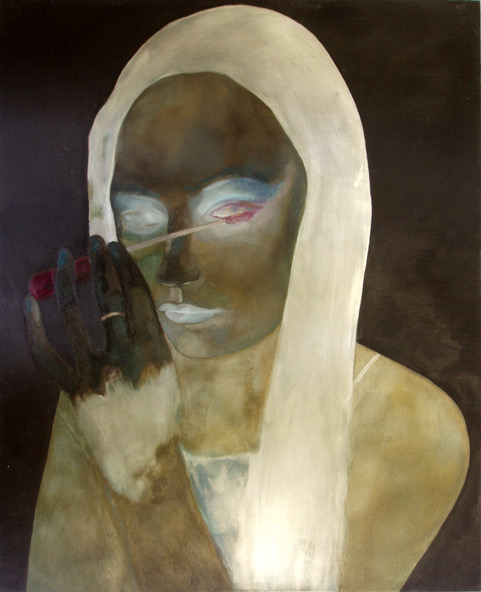
‘Mascara (Crete)’ – Oil on Steel – 50cm x 40cm. Private Collection
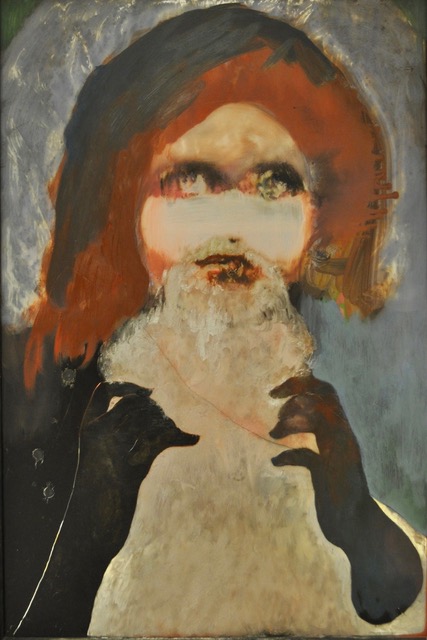
‘Ancestor’ – Oil on mirror, 70cm x 50cm. Private Collection
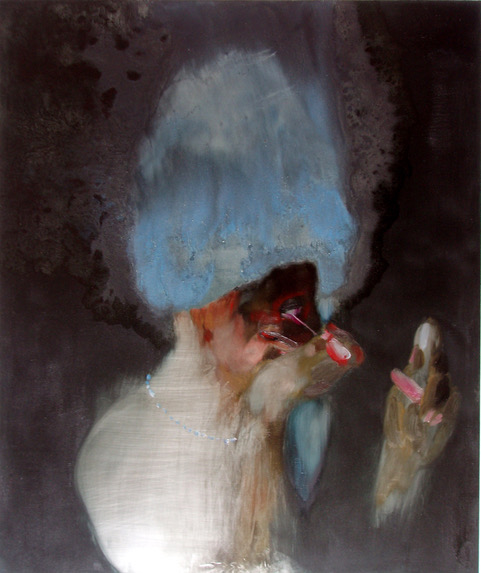
‘Mascara (Crete)’ – Oil on Steel – 50cm x 40cm. Private Collection
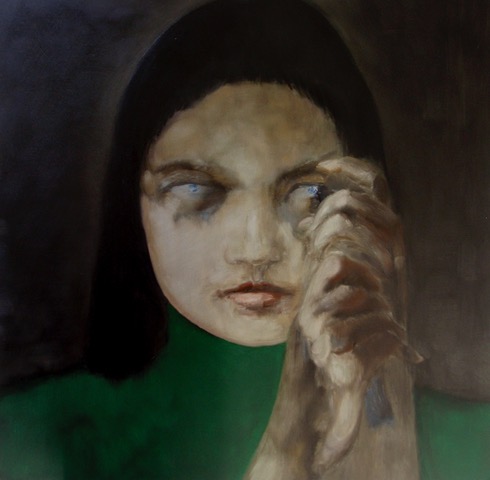
‘Exile’ – Oil on steel – 60cm x 60cm. Private Collection
‘In praise of collaboration’
One of Cornwall’s most influential contemporary artists, on ideas, energy and the joy of working together.
Cornwall Today April 2016
Words by Alex Wade

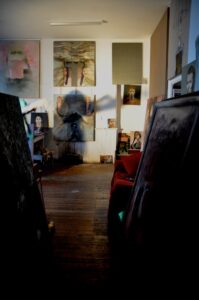
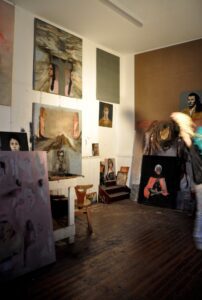 Photos of Studio then
Photos of Studio then
Some artists – perhaps, even, the majority – like to keep themselves to themselves. They work alone, taking inspiration from inner sources, the world around them, their past, their predecessors – anyone and anything, it seems, but other artists. Jesse Leroy Smith is not one of them.
“I like the idea of paintings making themselves, of taking myself out of the process,” Smith tells me, when we meet in his studio at the Newlyn School of Art. “In fact, the more I can take myself out, the better.”
As if to emphasise the point, Chris Priest, a fellow artist, is busy applying the finishing touches to a painting Smith will be exhibiting in this month’s Unstable Monuments show at the Old Bakery Studios in Truro. Priest is focused throughout, working intensely and with an almost spiritual absorption – it’s no surprise to learn that he’s a member of TAAP, a quartet of artists who create works together. TAAP – Team Artists Are Possessed – comprises Smith, Priest and fellow West Penwith artists Richard Ballinger and Sam Bassett. They’re playful, inventive, quirky and provocative – and, like many artistic ventures in Cornwall, a product of Smith’s restless imagination.
“TAAP came about at the end of 2010,” explains Smith. “I asked Chris, Richard and Sam to join me in making work for a show called Possessed Possessions. In one way or another we were each going through a difficult time back then. We put our energy into sculpture, film, performances and fashion shows. It was cathartic and even now, when we’re all in a much better place, we still come together to collaborate from time to time.”
Collaboration underpins the Unstable Monuments show (co-curated with Bath-based artist Matthew Benington.) “It’ll feature work from artists from all over the UK, and from Germany,” says Smith. “The work ranges from architectural installation to digital media, quilt-making and shoemaking to printmaking and painting. The idea is to highlight the fluidity of many of society’s touchstones, from faith and belief to gender and dance, showing how they’re in a state of flux – and how this is a cause for joy and optimism, not fear.”
Smith has been behind some of Cornwall’s most notable shows, from the Revolver project in 2007 to ART 75 and PRINT!. Revolver, co-curated with Volker Stox, saw the PZ Gallery – a former car showroom – given over to work by more than 60 artists for a six-week period over summer 2007, complete with a party on Friday nights. It spawned a book, many friendships and critical acclaim, as did the ensuing, PRINT!, ‘Suspended Sentences’ and ‘Darkrooms’ shows.
Smith eloquently sums up the rationale behind these and many other enterprises that bear his imprimatur: “I strongly believe that it’s very important to be part of an artistic community, that by working together artists can generate synergy, ideas and inspiration. And it’s crucial to the success of art in Cornwall.”
Smith moved to Cornwall in 2001 with his partner Sharon and their two children, Sethe, 19, and Caleb, 15. “We had been thinking of moving to Greece but came here on holiday, and fell in love with the place,” says Smith. The family settled in Penzance, with one small concern: “I was a bit worried that moving so far away from London might be isolating,” says Smith. “But it wasn’t. I was struck at once by how integrated the artistic community is.”
Smith was born in [1966 ] in London. He grew up in Woodford, in north East London, and recalls his upbringing as one in which “I was always making things, from go-carts to camps – and I was often out with my dad, who restored fireplaces, going back and forth from various London markets like Camden and Swiss Cottage.” Smith also pays tribute to his art teacher at Woodford Bridge School, Sue Evans. “She was inspirational. She played a big part in helping me get to East Ham Polytechnic, where I did an art foundation course.”
After the foundation course, Smith spent a year taking a number of adult education courses, particularly in life drawing and black and white photography. Then, from 1985 to 1988, came a BA (Hons) in Fine Art at Norwich School of Art, a period Smith enjoyed hugely. Not only did he meet Sharon there, but also “a number of artists who are still friends now – it was a great time.” His tutor then, the acclaimed Brazilian artist Ana Maria Pacheco, was influential – perhaps, as much as anything else, in adopting multiple media, from painting and printmaking to installation and performance: Smith himself doesn’t confine himself to a single form.
Further study was to come. “After Norwich I lived in an Acme Studios house in Leytonstone next to Jacques Nimki, another artist. We both applied to the Royal Academy of Art, not for a moment imagining we’d both get in – but we did.” Looking back at his time at the RA, Smith has a touch of regret: “I should have made more of it. But I found it a bit claustrophobic and archaic. I spent a lot of time travelling then, visiting Greece and Turkey. But I should have more of the RA schools.”
But perhaps it’s no surprise that Smith wasn’t the most diligent post-graduate student. By then he was set on his own path, one which would see him make a living as a pavement artist – “I worked outside John Lewis on Oxford Street for quite a while – when the police weren’t moving me on, that is” – creating outsize artworks in abandoned industrial spaces used for raves, and produce abstract, elemental paintings informed by his sense of the landscapes of Greece and Turkey. His painting evolved again with the births of Sethe and Caleb: both would feature regularly in Smith’s work, now generally more figurative and at once tender and considered, and yet visceral and even, at times, disturbing.
Smith sees painting as a meditative act. “You forget why you’re doing it, when you’re doing it,” he says. He has a collection of scrapbooks dating back many years, with all kinds of images – these inform his work, as do any number of other prompts, from childhood memories and Sanskrit poetry to African art and Aztec sculptures. Whatever he creates, it is imbued with an enigmatic sensibility, as if a question lurks around the corner, forever unanswered; as if there is always something else to search for but no guarantee that it will be found.
This, and Smith’s commitment to a collaborative ideal in art, make him one of the most interesting and, indeed, influential artists at work in Cornwall today.
3 photos all Newlyn Studio 2016 at time of interview with fellow artist Chris Priest.
Michael Angove MA RCA
www.michaelangove-drawing.co.uk
Jesse’s powerful portraits chart the shifting contours of the sovereign face.
Imbued into his oil paintings are layers of geology, tribalism and topography to arrive at a mythological vision of a face at once both youthful and wizened.
The gender ambiguous figures in his paintings could be a child prince, goddess or warrior. They are effigies of who we were or could be. They are ancient visions of ourselves or mirror our hidden selves.
Through presenting the sitter with age, gender and position in a constant state of flux, Jesse’s paintings suggest that we are a community that should be aware of its interconnectedness to one another, to the Earth and to the incorporeal.
His palette and paint quality is elemental, as he uses coppers, bronzes and viridians to quarry the spirit of the sitter as an icon of culture. Ochres and Triassic reds, tribalize the canvas to access pre-history and a Nomad sense of early life, rich in honesty and wonder.
Jesse’s gaze asks the question what or who is holy, and should we, can we worship our friends and family, or ourselves as deity?
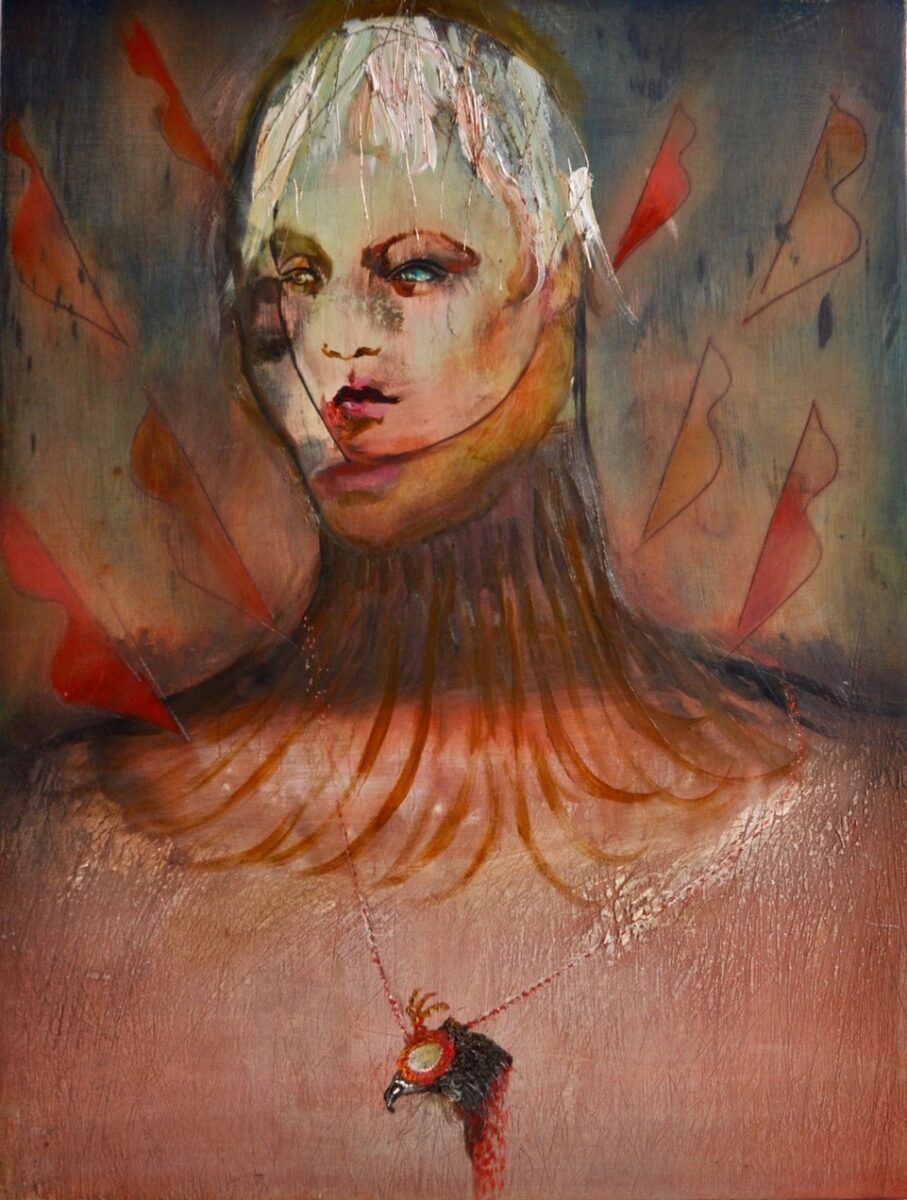
‘Take Me to the Mountain’ – Oil on Copper – 55cm x 45cm – Private Collection
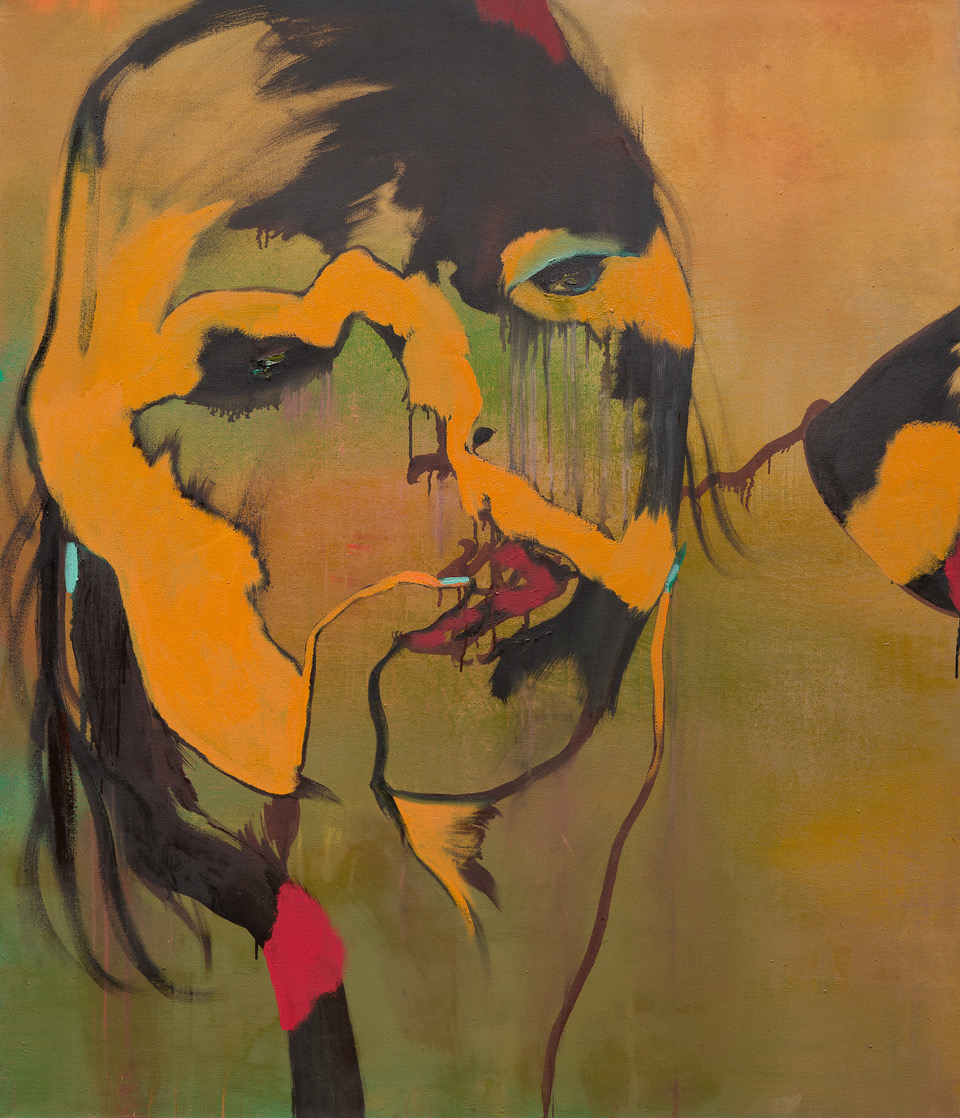
‘The Good Son’ – Oil on canvas – 140cm x 120cm
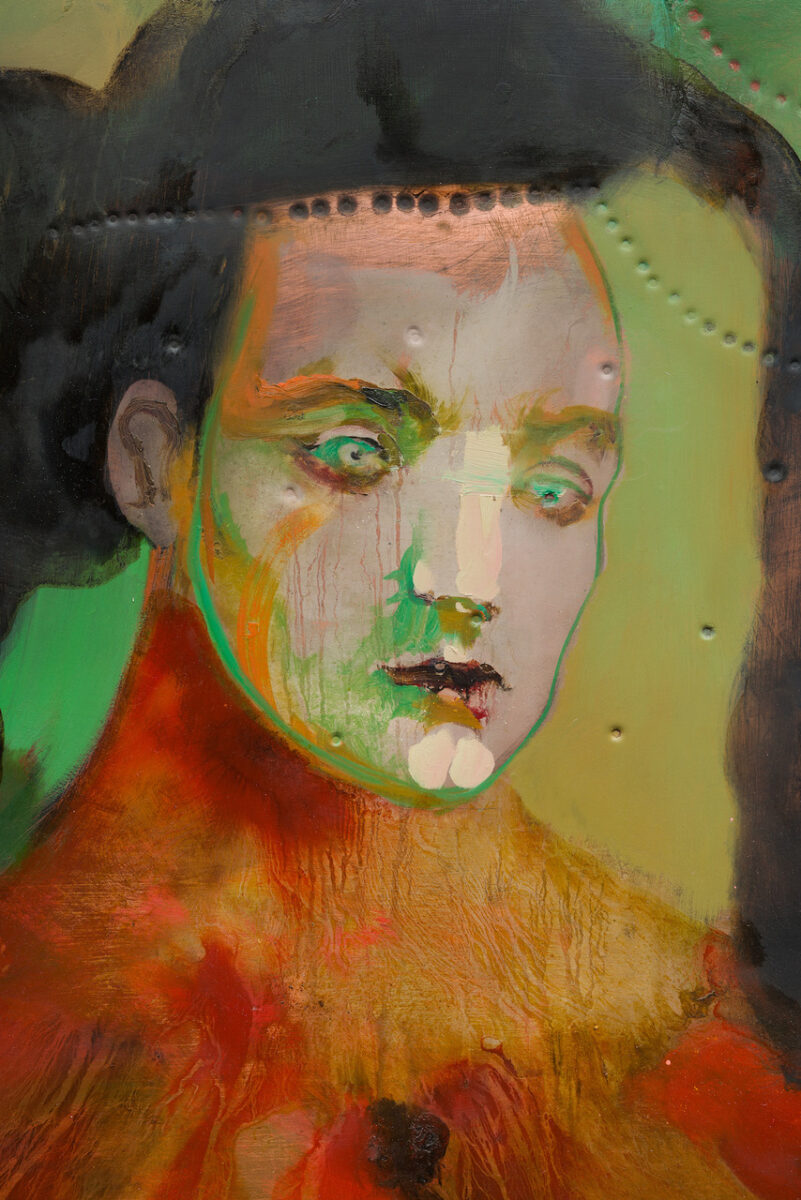
‘Bloodline’ detail – Oil on copper – 100cm x 80 cm
Depicting children: reflections on Jesse Leroy Smith at Goldfish Fine Art
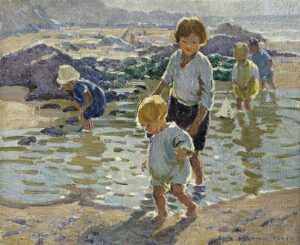
Some artists treat children like flower-arrangements: presuming them to be possessed of a simple and unproblematic beauty that can be portrayed in a straight-forward way. The smaltzy chocolate box images of Dorothea Sharp, who is famous for painting children by the sea-shore (often in Cornwall where she lived during the 1940s), is an example (right).
Most would agree that such bland and sentimental depictions do both art and children a disservice. They are so far from the reality of childhood that they are barely recognisable, and seem to inhabit a largely fictitious Enid Blyton world. Children are far more interesting beings than these one-dimensional idylls would suggest. They are not passive objects, and our relationship with them, and the way we see them is complex on many levels.
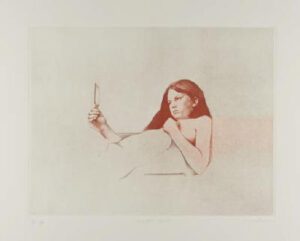 Depicting children in a way that goes beyond kitsch is a tricky business, however. Because they are dependent on adults, and not yet fully formed or knowledgeable about the world, using them as subjects for serious art undoubtedly risks exploiting them. Is it right to assume that they have consented to be painted, or if they have consented, did they understand what they were consenting to?
Depicting children in a way that goes beyond kitsch is a tricky business, however. Because they are dependent on adults, and not yet fully formed or knowledgeable about the world, using them as subjects for serious art undoubtedly risks exploiting them. Is it right to assume that they have consented to be painted, or if they have consented, did they understand what they were consenting to?
We are most conscious of this thorny issue if child models are used in a way that is explicit or sexualised in any way. The Cornish painter Graham Ovenden, living near Bodmin and one of the Brotherhood of Ruralists, is (in)famous for his shameless images of children in states of undress. Many are – remarkably – in the Tate collection (left).
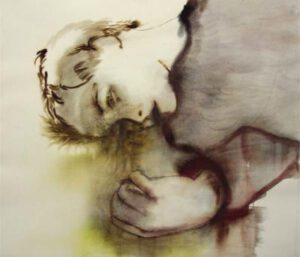 Of course the gaze of a painter is generally different to that of a parent, (though arguably both gazes are a form of love or caring). Parents of young toddlers will know that being watchful or vigilant of a child’s safety is probably one of the most onerous responsibilities that comes with parenthood. In fact there is a huge literature on the role of the gaze at this early stage of development. The psychoanalyst Donald Winnicott for example, emphasised the importance of the infant seeing him or herself reflected back to them in the emotions expressed on their mothers face.
Of course the gaze of a painter is generally different to that of a parent, (though arguably both gazes are a form of love or caring). Parents of young toddlers will know that being watchful or vigilant of a child’s safety is probably one of the most onerous responsibilities that comes with parenthood. In fact there is a huge literature on the role of the gaze at this early stage of development. The psychoanalyst Donald Winnicott for example, emphasised the importance of the infant seeing him or herself reflected back to them in the emotions expressed on their mothers face.
The contemporary Cornish painter, Jesse Leroy Smith, explores some of these issues whilst simultaneously steering between both bland platitudes and frank exploitation (lower 3 images).
His work is most commonly derived from studies of his own children. They often appear involved in role-playing games which evoke the symbolism of the feral child (eg dressed up as animals, or playing with bows and arrows). This is an established and recognised theme in literature particularly (eg Lord of the Flies, Peter Pan), and it is linked to modernism through the figure of Jean-Jacques Rousseau (Emile).
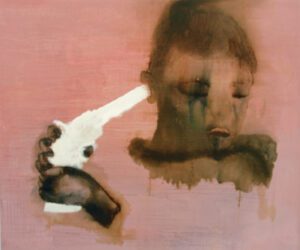 His most recent paintings, on show at Goldfish Fine Art, are executed on a large scale using powdery oil colours. Rubbed and worn in places, they look like distempered frescoes. As well as children, they are populated by subjects who appear somewhat older. These figures are still sexually ambiguous, and have pale or golden translucent complexions and big eyes, like characters from computer games or manga comics.
His most recent paintings, on show at Goldfish Fine Art, are executed on a large scale using powdery oil colours. Rubbed and worn in places, they look like distempered frescoes. As well as children, they are populated by subjects who appear somewhat older. These figures are still sexually ambiguous, and have pale or golden translucent complexions and big eyes, like characters from computer games or manga comics.
Ghostly and ethereal, and painted behind veils of translucent turpentine, they appear narcissistic and uncertain, as if they are entering into the period marking the gradual transition from childhood to adulthood.
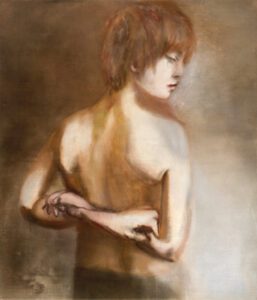
The adolescent has become an increasingly important element in contemporary art (eg Rineke Dijkstra, Muntean/Rosenblum) probably because of the pervading presence of youth culture, which affects all of us in so many ways. Products are marketed with a youth market in mind because most adults aspire to be youthful. Some even seem to live in an extended adolescence, thanks to plastic surgery and an obsession with looking young. Conversely, children are expected to both achieve more at school, and cope with pressures to become sexualised at an earlier age.
In fairness to Dorothea Sharp and her generation of artists, adolescence and youth culture is to a large extent peculiar to our post-modern age. Indeed, as it becomes an ever increasingly powerful and influential force in society, the need to consider and understand its representation and commodification becomes ever more important.
Look Back in Wonder – Words by Mercedes Smith
A new exhibition at West Cornwall’s Tremenheere Gallery explores ‘a decade of upheaval and mayhem’ for artist Jesse Leroy Smith.
“This show” says Jesse Leroy Smith, referring to his forthcoming, first-in-a-decade solo exhibition “is a form of apology. As a parent, a son, a friend, a lover, it’s impossible not, on some level, to fail. This exhibition is my attempt to makes sense of failing to cope with being human.”
Failure isn’t something you would typically associate with Jesse. As the ideas man behind countless collaborative exhibitions and public arts events, he is regarded by many as a veritable Pied Piper of contemporary art, a man of “energy, creativity and selflessness” according to artist and film maker Roger Thorpe “making things happen where others fear to tread. A creative collaboration with Jesse is like opening a door onto a landscape that is forever changing in new and mysterious ways”.
Over the last ten years, by bringing together large groups of artists, performers, educators, experts, arts organisations and the general public, Smith has initiated numerous multimedia shows in disused and transitory spaces, that in turn have been reinvented as public art venues. As a curator and creative collaborator, he has been responsible for many of the South West’s most progressive art shows, including Unstable Monument, a multi-artist exhibition curated with Matthew Benington held in a wharf-side factory in Truro, now the established Old Bakery Art Studios; Suspended Sentences, a showcase of visual art responses to poetry curated with Mark Spray held in an abandoned Newlyn fish factory, now the much-loved Newlyn Filmhouse; Darkrooms, an immersive arts event that launched West Cornwall’s CAST Arts Centre in 2013; ART 75, which celebrated the 75th anniversary of Penzance’s iconic Art Deco lido, curated with Richard Ballinger with the work of 90 different artists in 75 changing cubicles and in the water itself; Revolver, a six week, 60 artist project curated with Volker Stox that showcased a wealth of rising talent from Cornwall’s art scene; and PRINT! at the Penzance Exchange, which brought together students, graduates and respected artists in a survey of international printmaking curated with Bernard Irwin . ‘Jesse has been one of the most active and important artists in Cornwall” says Rupert White, editor of respected online journal Art Cornwall. “His generosity and vision as a mentor and curator have influenced countless others”. Artist and writer Paul Becker, who collaborated with Smith for the Newlyn Society of Artists exhibition Double Vision in 2009, shares this sentiment, telling me “Working with Jesse taught me a very great deal about myself as an artist, especially that making artworks can be both incredibly serious and deeply hilarious at the same time”.
However active, important and influential Smith’s career may have been in recent years though, it has also been, in his own words, “a decade of upheaval and mayhem, personally speaking”.
He describes his new exhibition, Force Majeure, on show this June at West Cornwall’s spectacular Tremenheere Gallery and Sculpture Gardens, as a “confessional portrait”, a new beginning that seeks to lay bare, and move on from, “personal preoccupations and regrets”. Loss, loneliness, alcohol addiction, and the resulting battle with depression are situations from which he is emerging in the spirit of self-awareness and creative enrichment. Though Smith, true to form, has pulled in numerous high-profile collaborations for the show’s opening and closing events, the exhibition is essentially a one-man show which looks back at his collaborative past, and towards a new phase of future work. Force Majeure (defined both as an “irresistible compulsion” and an “unforeseeable circumstance that prevents the fulfillment of a promise”) begins with the artist’s scrapbooks: filled with images of friends, family and heroes of film, music and literature, as well as religious iconography, ancient art, fashion photography, film stills and the mementos of Smith’s extensive travels, they reveal an artist thrilled by imagery from every place and time. The exhibition then unfolds into an arcade of paintings, collages, photographs, films and books, which form a processional journey to the gallery’s first floor, where a vast frieze draws together a decade of influences and experiences.
With collaborations from artists Caleb and Sethe Smith, Paul Becker, Roger Thorp, Taap, Sam Bassett, Volker Stox, Bernard Irwin, Chris Priest, Richard Ballinger and more, the exhibition’s opening night will include performances and readings, and the show will close a month later with what Smith describes as “a rampant solstice celebration!”, specifically a tour of Tremenheere’s gardens that will feature soundscapes, film, performances and site specific artworks, and, intriguingly, “a banquet of talks, poetry and the spoils from an earlier forage in the local woods”.
“Painting, for me, is a medium of doubt and speculation” says Smith, who describes his various projects to this point as “sometimes anarchic, sometimes rehabilitating”. “This show” he says in conclusion “has given me a place to question the balance between my collaborative and individual expression, and to resolve my past and embrace my future as a contemporary artist”.
See Force Majeure from 25 May to 23 June at Tremenheere Gallery, Tremenheere Sculpture Garden, Gulval, Penzance, Cornwall, TR20 8YL. All are welcome at the opening event on Friday 24 May, and at the Summer Solstice celebrations on Friday 21 June. See www.tremenheere.co.uk for details.


